Nio, the Chinese automaker often compared to Tesla, officially launched in the European Union on Friday, October 7th. Nio has been present in Europe since October 2021, but only in Norway. It is now possible to purchase the three new electric vehicles from the brand in Germany, Denmark, the Netherlands, Sweden, and Denmark. For France, patience is required, as the launch is planned for 2024 under a different brand (ALPS), with more affordable models.
The lineup consists of three vehicles: the Nio ET5, Nio ET7, and Nio EL7. The latter is called ES7 in China, but the manufacturer had to rename it due to a dispute with Audi. Volkswagen’s brand sued Nio, as the Chinese model names ES6 and ES8 are considered too close to Audi S6 and S8. This case reminds us of the one between Citroën and Polestar.
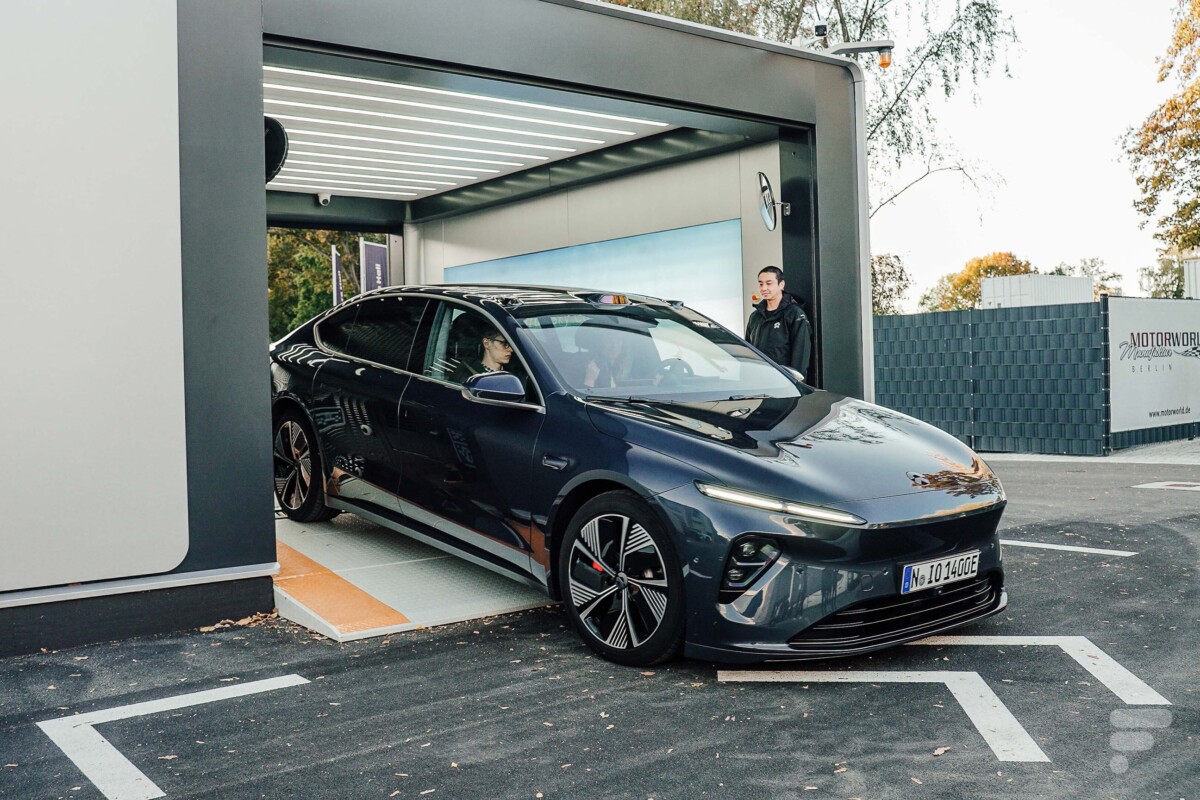
The Nio ET5 is a luxury sedan, comparable to the Tesla Model 3 or Mercedes EQE. The Nio ET7 is a sedan/limousine, similar to the Tesla Model S or Mercedes EQS. Finally, the Nio EL7 is the SUV version of the ET7, akin to the Tesla Model X or Mercedes EQS SUV.
The comparison with these market benchmarks is not random. Nio is a young startup, financially backed by the Chinese government, and only produces electric vehicles, making it similar to Tesla. However, its target audience, pricing, and ambition to be perceived as a luxury brand align it more closely with Mercedes.
Nio invited us to Germany to discover the brand, the three models, and their ingenious battery swap system, which allows you to leave with a fully charged battery in just five minutes. We had the opportunity to spend a whole day driving the Nio ET7 equipped with a 100 kWh battery. Here is our detailed and comprehensive review of the car.
Technical Specifications
| Model | Nio ET7 |
| Dimensions | 5.101m x 1.987m x 1.509m |
| Power (horsepower) | 652 hp |
| 0-100 km/h | 3.8 seconds |
| Autonomy level | Partial autonomy |
| Top speed | 200 km/h |
| Main screen size | 12.8 inches |
| Car-side plug | Type 2 Combo (CCS) |
| Entry-level price | 78,000 USD |
| Price | 67,000 € |
The Nio ET7 has an attractive design, but the LiDAR is too prominent
The Nio ET7 was unveiled in January 2021 in China. It is a long sedan (5.10m) with a generous wheelbase (3.06m). However, the design aims to avoid giving an impression of length. The sportback coupe-like rear of the sedan helps prevent a bulky appearance.
The silhouette is clearly sporty, with sleek lines on the roof. At the rear, Nio adds a hint of shooting brake to its car. The lighting signature, featuring a wide LED on either side of the rear, gives the vehicle a futuristic aspect. It is worth noting that it is a four-door car, with a trunk rather than a hatchback like a five-door model.

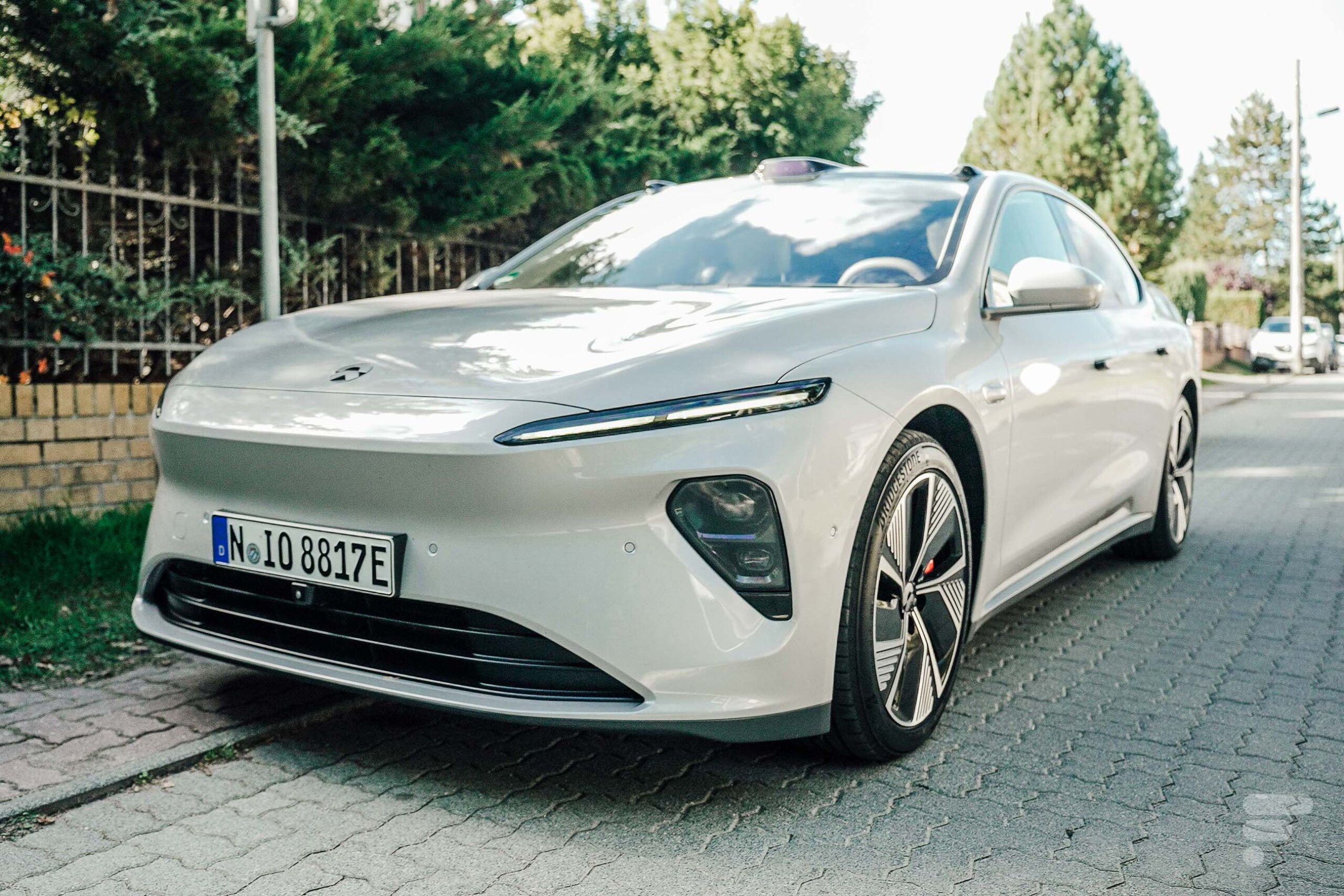
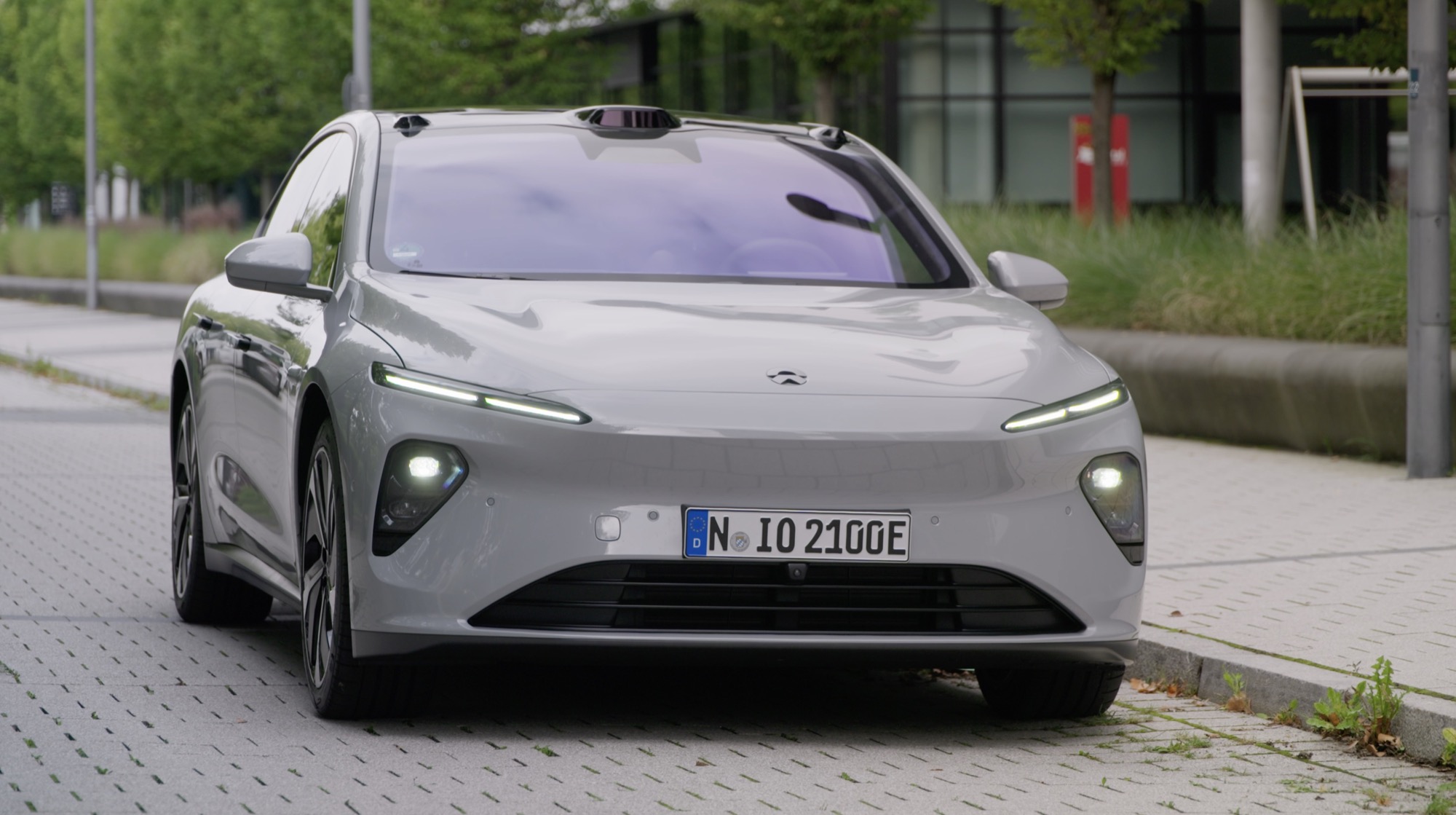
The front of the car is probably the most distinguishing feature compared to competitors. The full grille, reminiscent of a shark, and the daytime running light signature contribute to this distinction. The openings for the low beams and fog lights give the impression of a gasoline-powered car with air intakes.
The only real air intakes are located below the license plate. These are active flaps that open and close as needed to cool the battery.

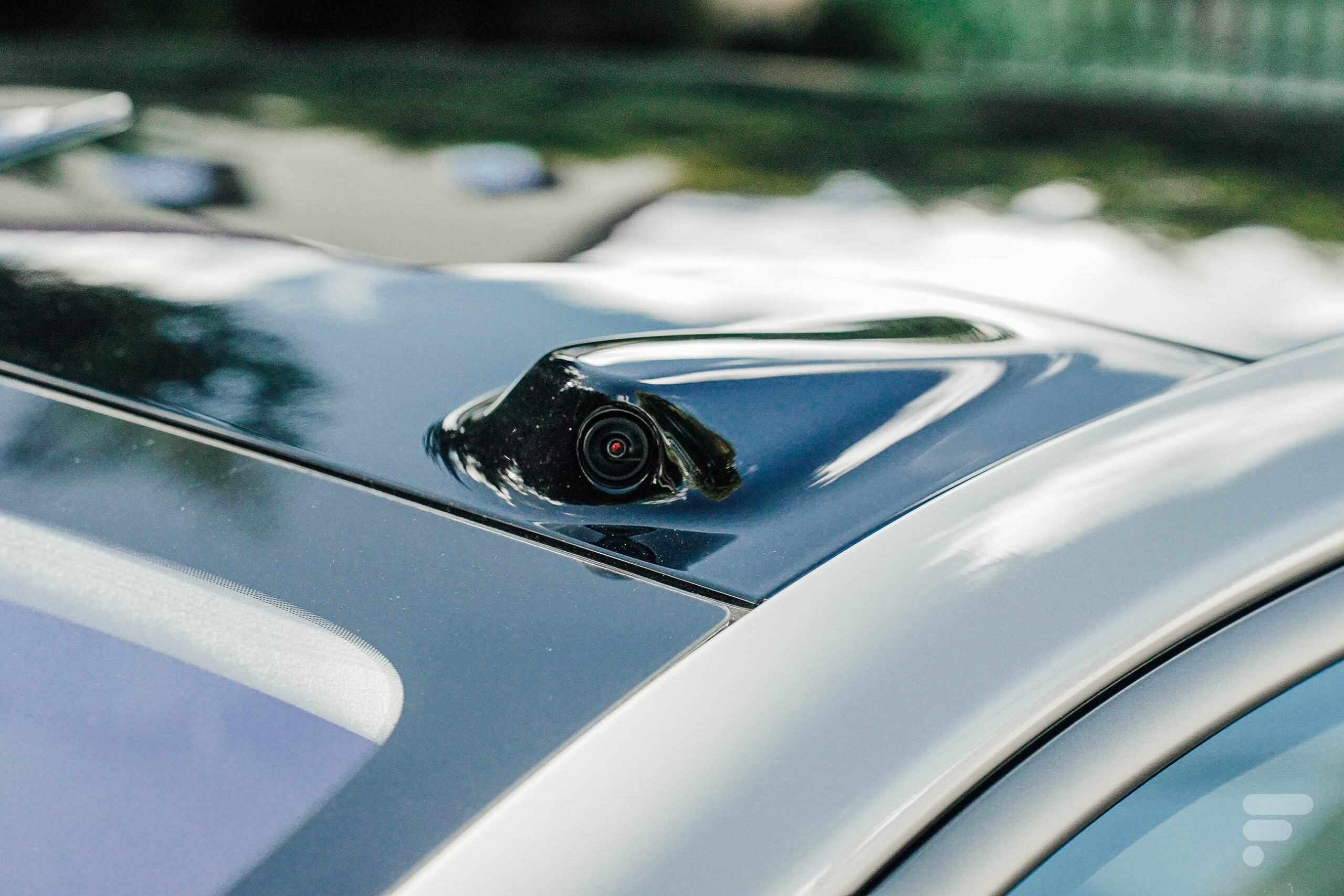
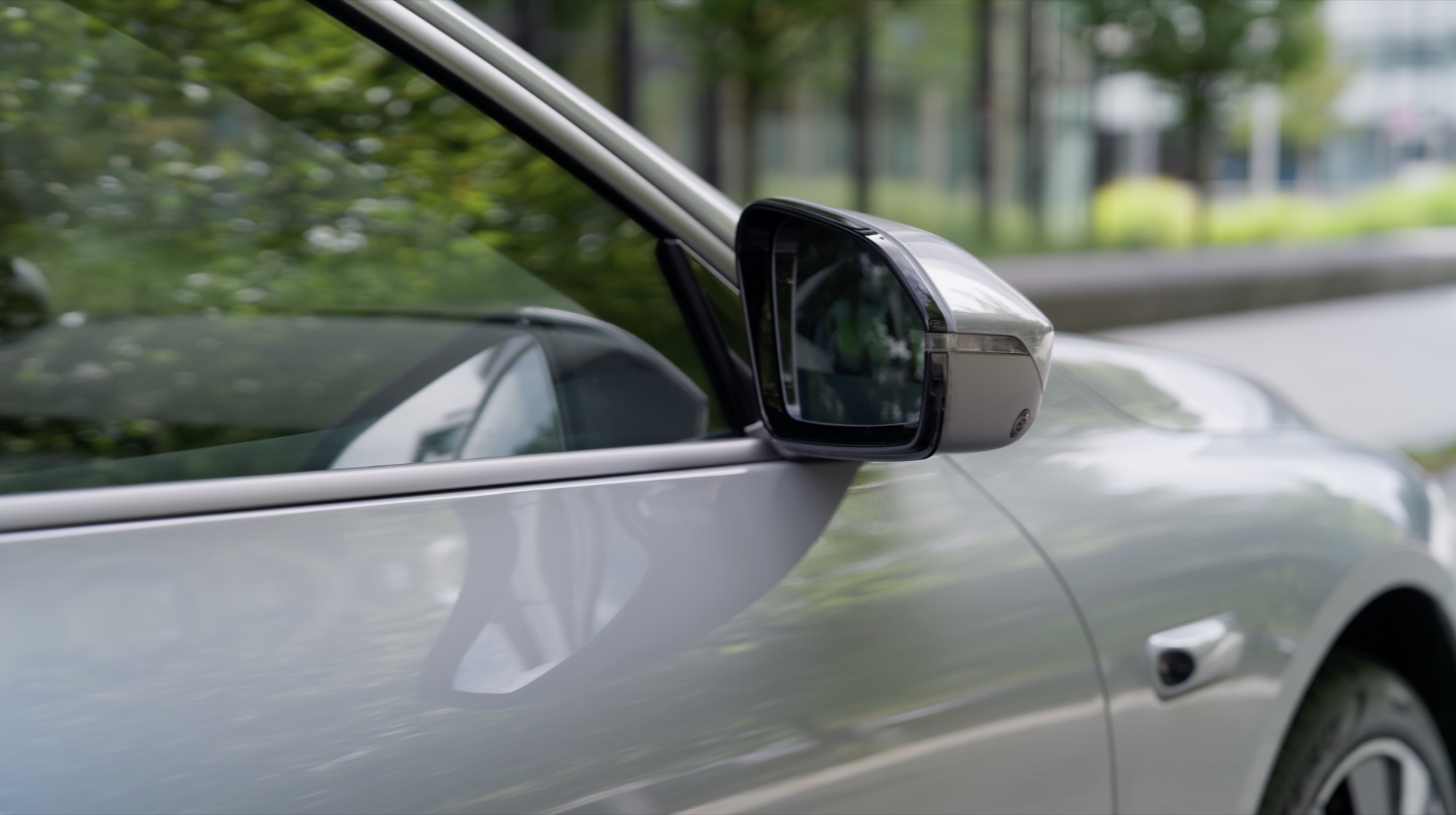
It’s impossible to discuss the design without mentioning the LiDAR mounted on top of the windshield and the two cameras on the pillars on either side of the car. Let’s be honest, these three elements stand out when looking at the vehicle head-on. The cameras seem to mimic air intakes, and any resemblance to the Peugeot 406 from the movie Taxi is purely coincidental.
Indeed, the LiDAR gives the sensation of being face-to-face with a taxi. It’s easier to understand why Elon Musk refuses to use LiDAR in Teslas. On the contrary, the Mercedes-Benz EQS with LiDAR (in its Level 3 autonomous driving version called Drive Pilot) incorporates it in a much more elegant and concealed manner, directly into the grille.
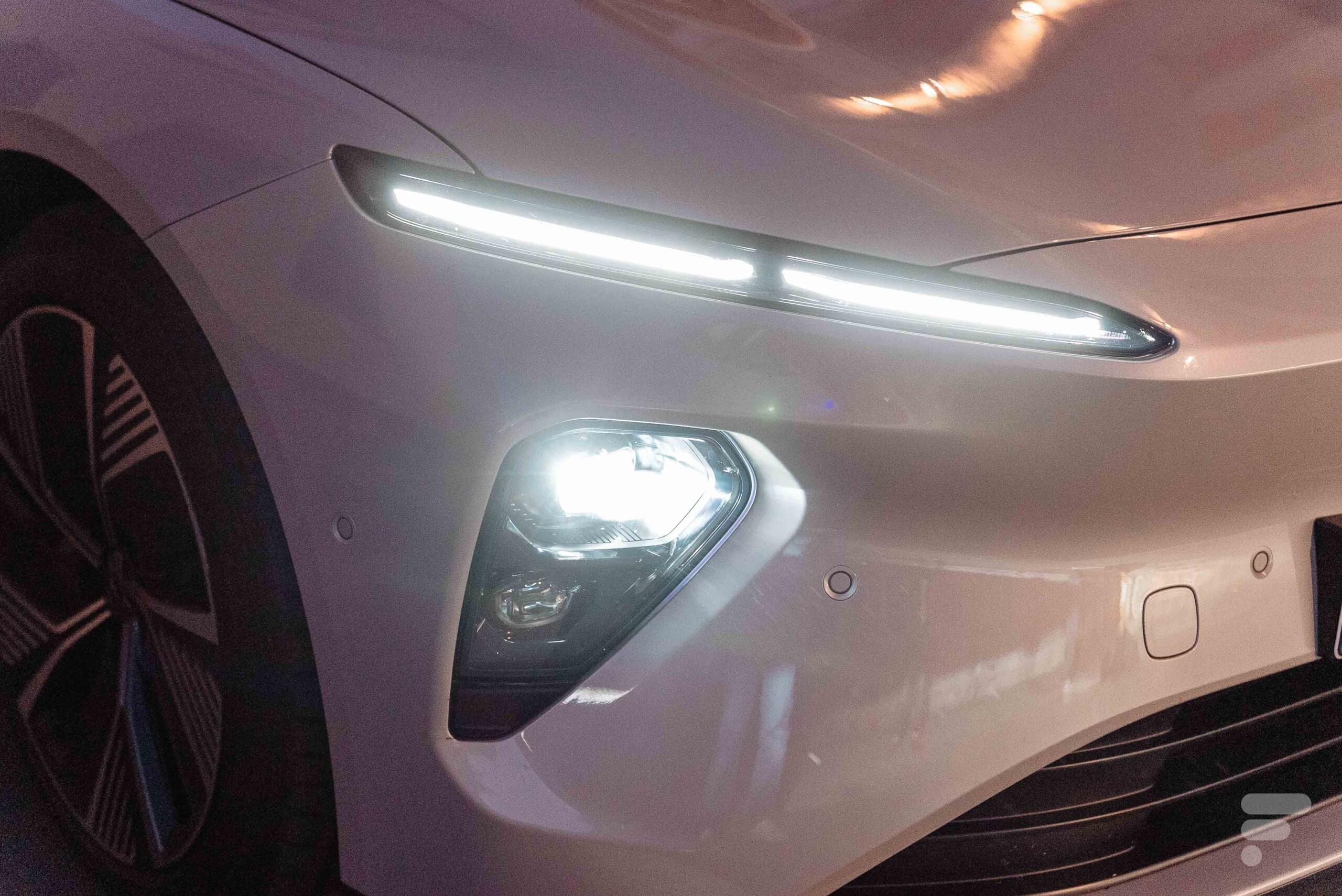
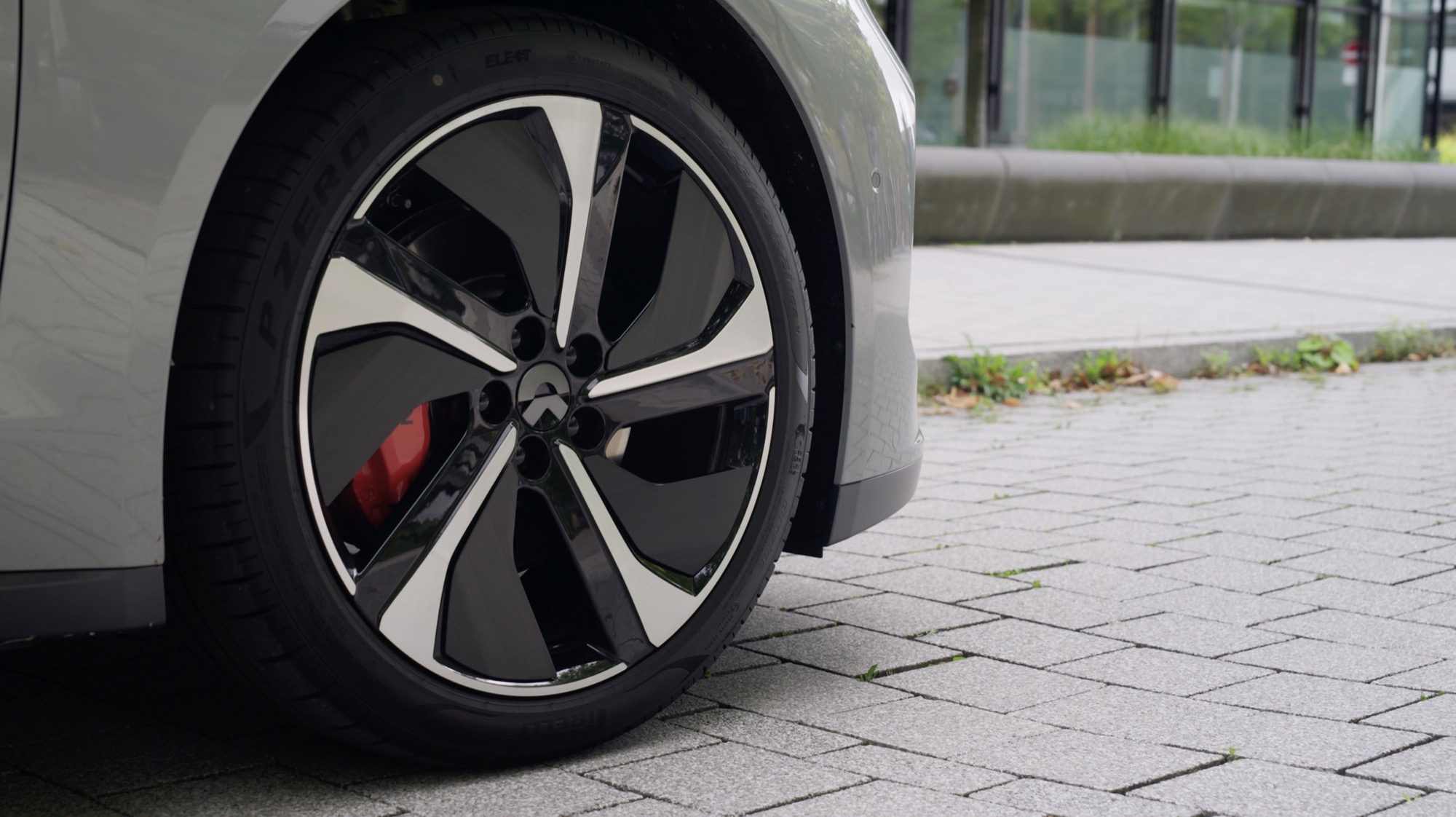
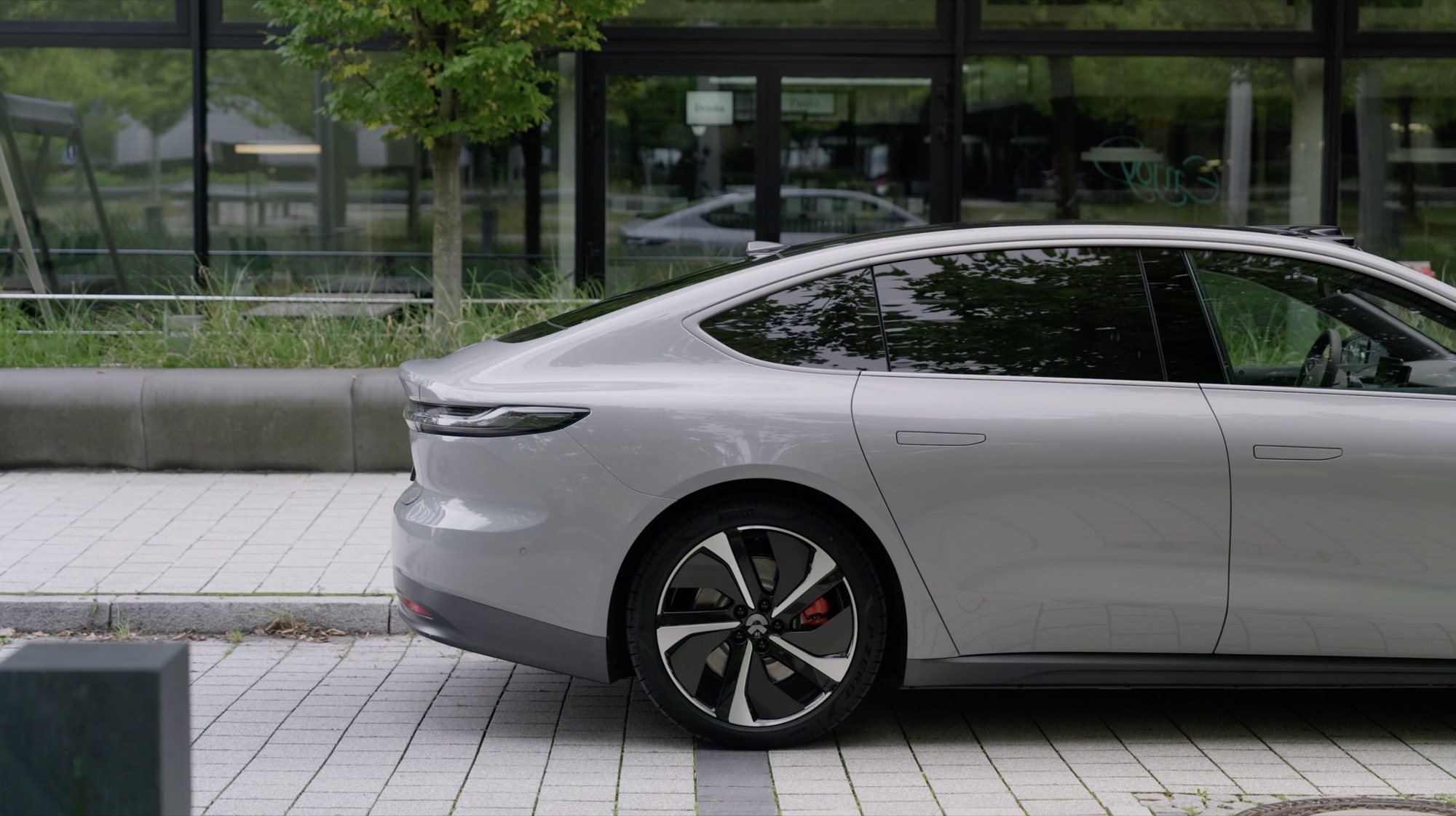
Our test model had 20-inch wheels, which allow for the highest possible range. The 21-inch wheels give the car an even sportier look. Our model also had the option of orange brake calipers, adding a touch more sportiness to the design.
The handles of all four doors have a retractable mechanism to enhance the car’s aerodynamics and aesthetics. The handles extend when the car is unlocked and retract once it is started.
If the car is not unlocked and you want to get in, it will detect your presence (and the key in your pocket) and automatically open the door slightly. You then only need to pull the handle to fully open the door and get inside.
Interior Space
Now, let’s talk about the interior, which is reminiscent of a small limousine. As soon as you get in, you notice the comfort and softness of the leather seats (electrically adjustable in 14 positions), which offer heating, ventilation, and massage functions for the four main seats. In China, a vegan leather (synthetic) variant is available, but not in Europe.
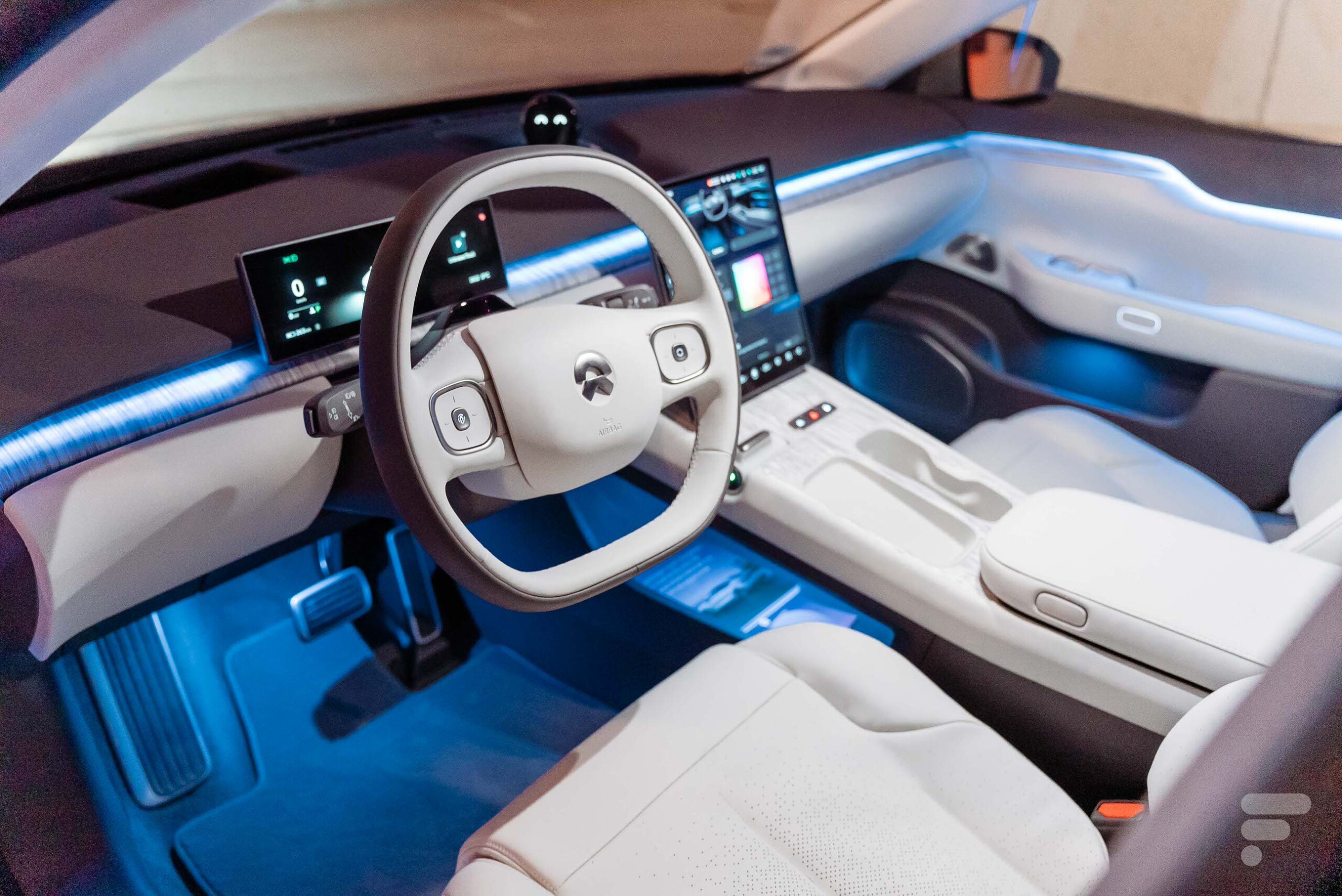
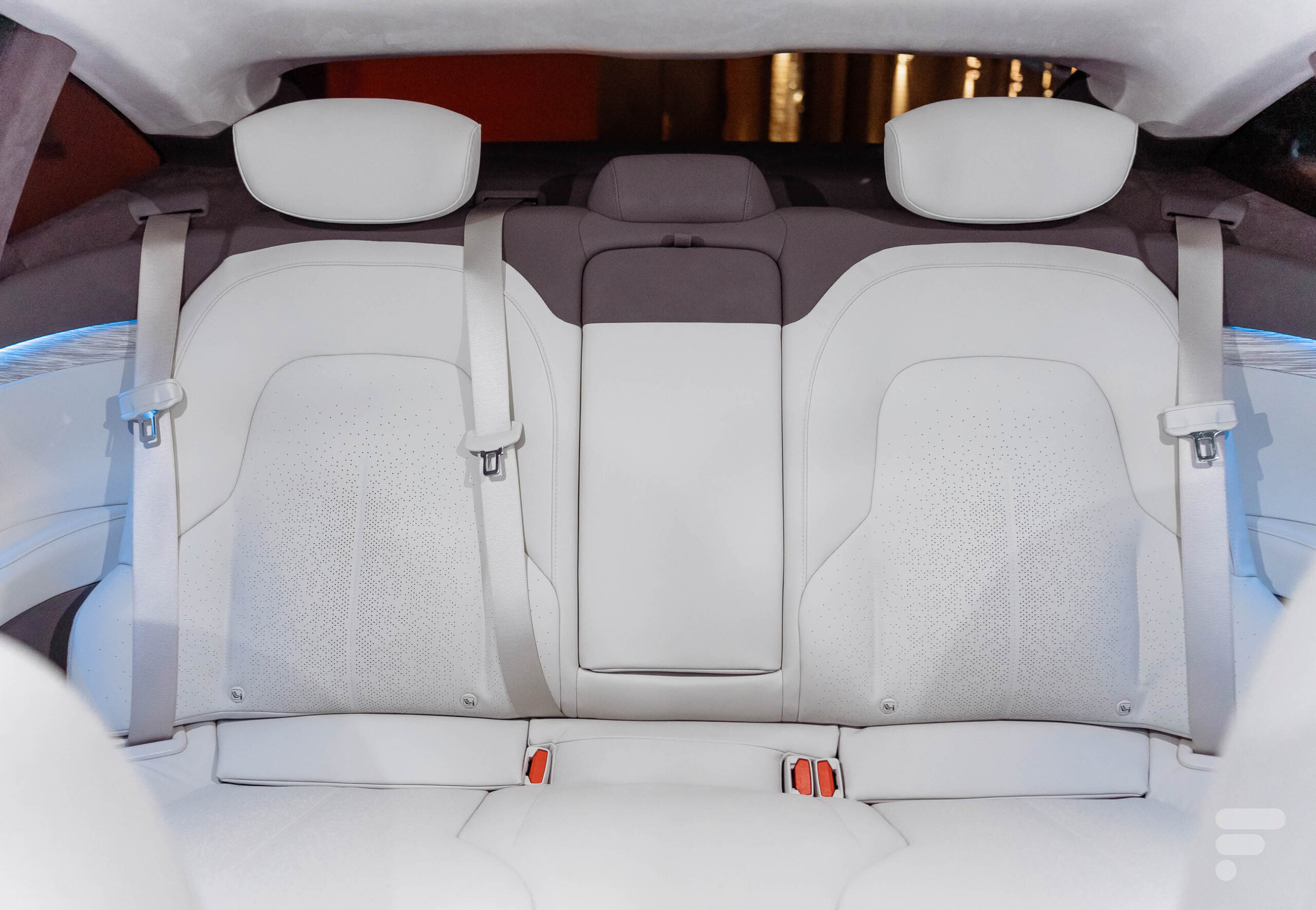
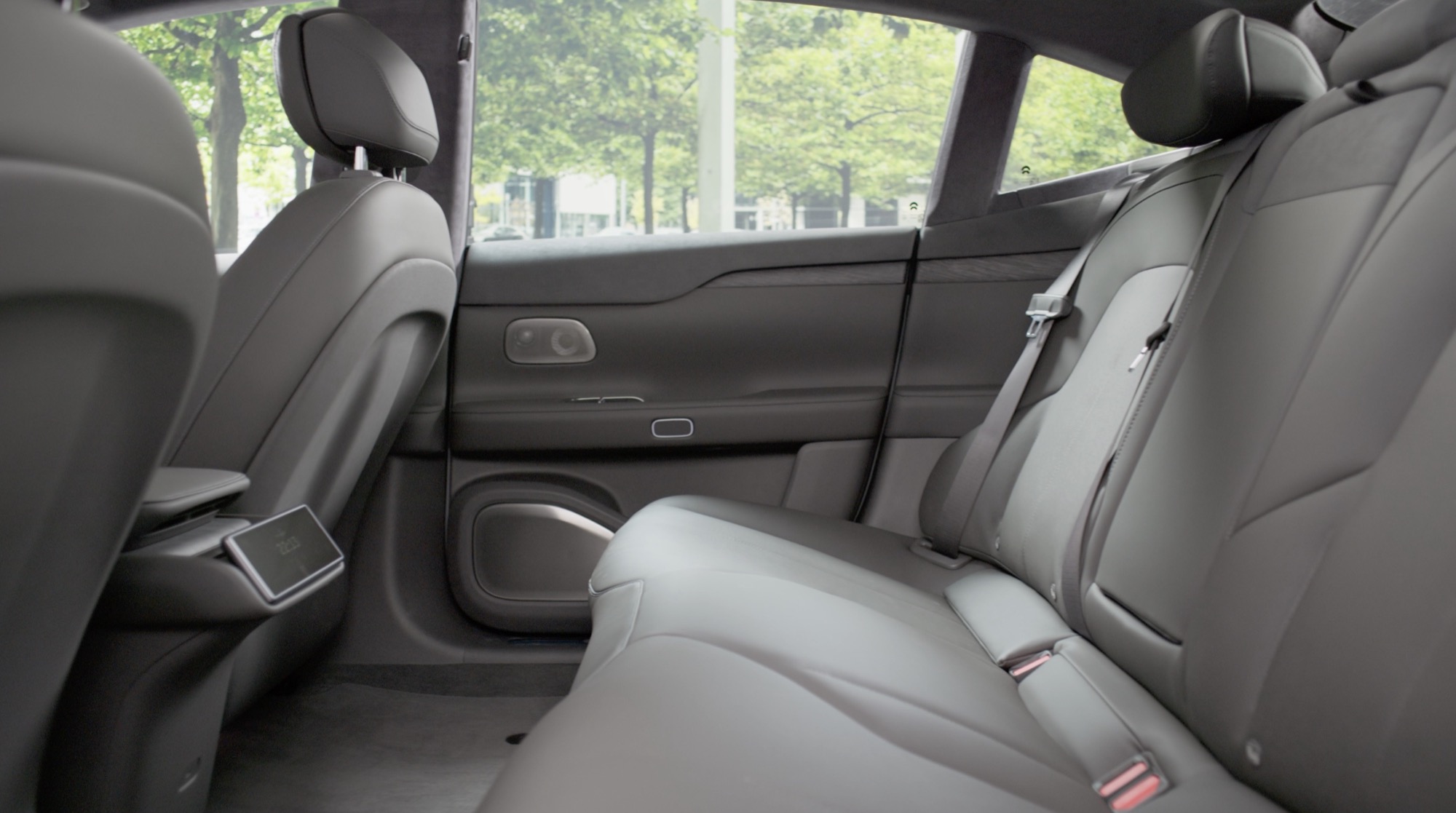
The rear seats are luxurious, featuring air cushions (like in the Mercedes S-Class) and providing excellent legroom (thanks to the generous wheelbase). As a bonus, passengers have a dedicated 6.6-inch screen to control the three-zone ventilation, volume, and even activate the “chauffeur” function. This feature moves the front passenger seat forward to give even more space to the right rear passenger.
For added comfort, there are four headrests with deformable mini-cushions inspired by aviation to support the neck during naps.

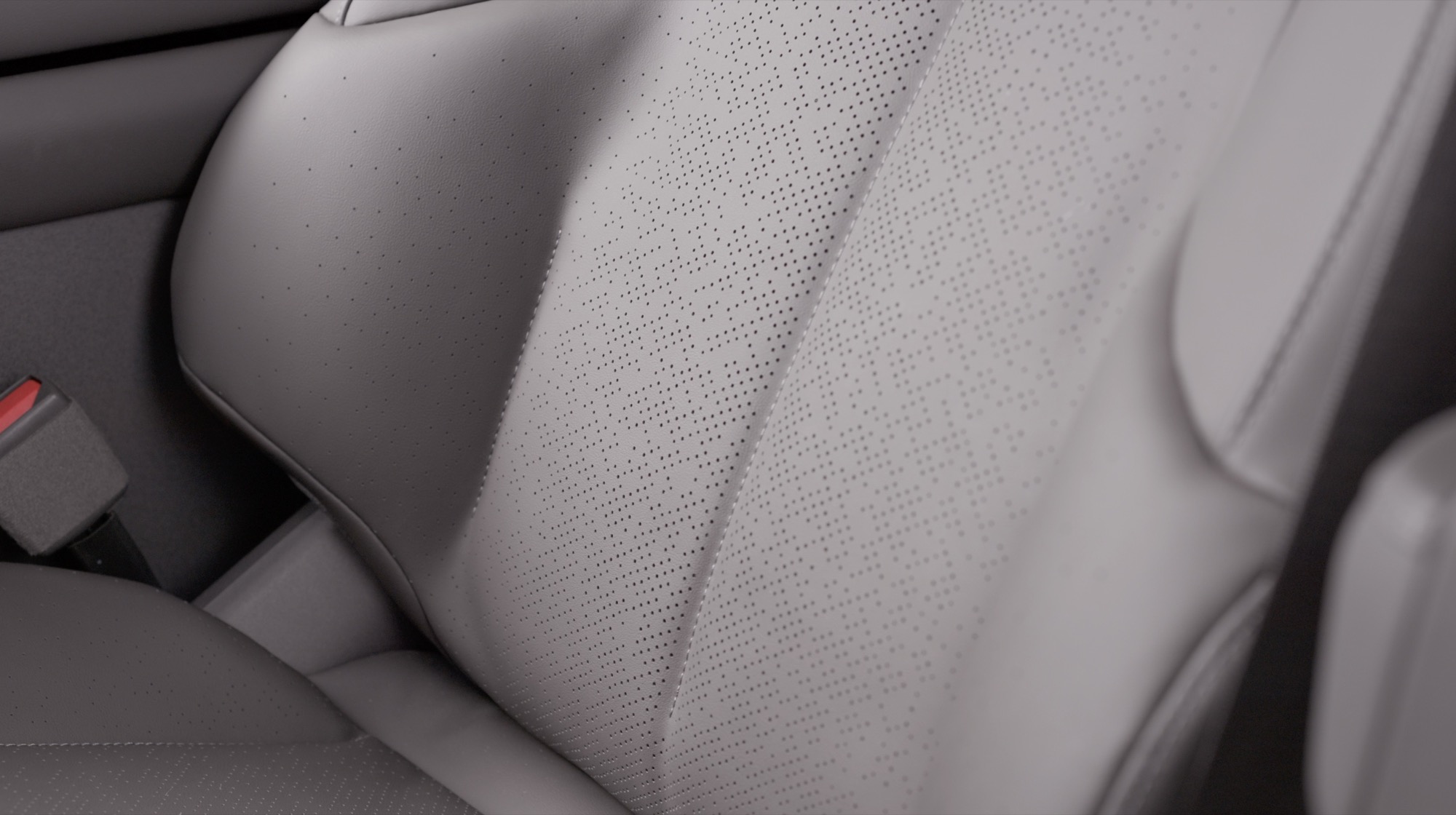
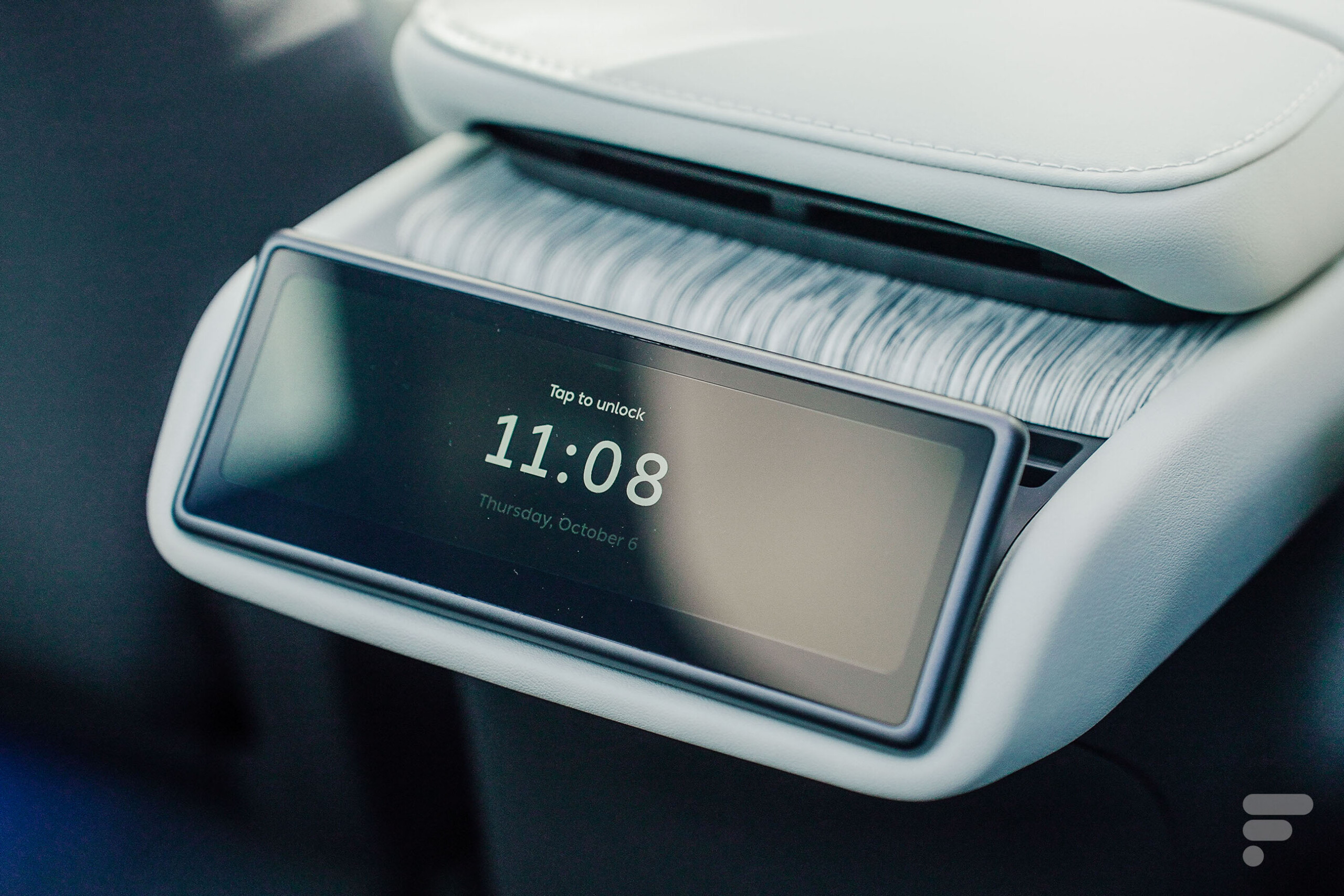
However, beware of the middle seat. Although the cushioning is softer than in most cars, the backrest is extremely hard, almost as hard as a wooden plank! The culprit: the massive center armrest, which offers two cupholders and a ski hatch.
Another downside of the Nio ET7 in terms of comfort is the high floor. Fortunately, the car is long, and it’s possible to stretch your legs, whether in the front or rear seats. As soon as you try to bring your legs closer to the seats for a more seated position, your knees end up higher than your hips, which can be uncomfortable on long journeys.
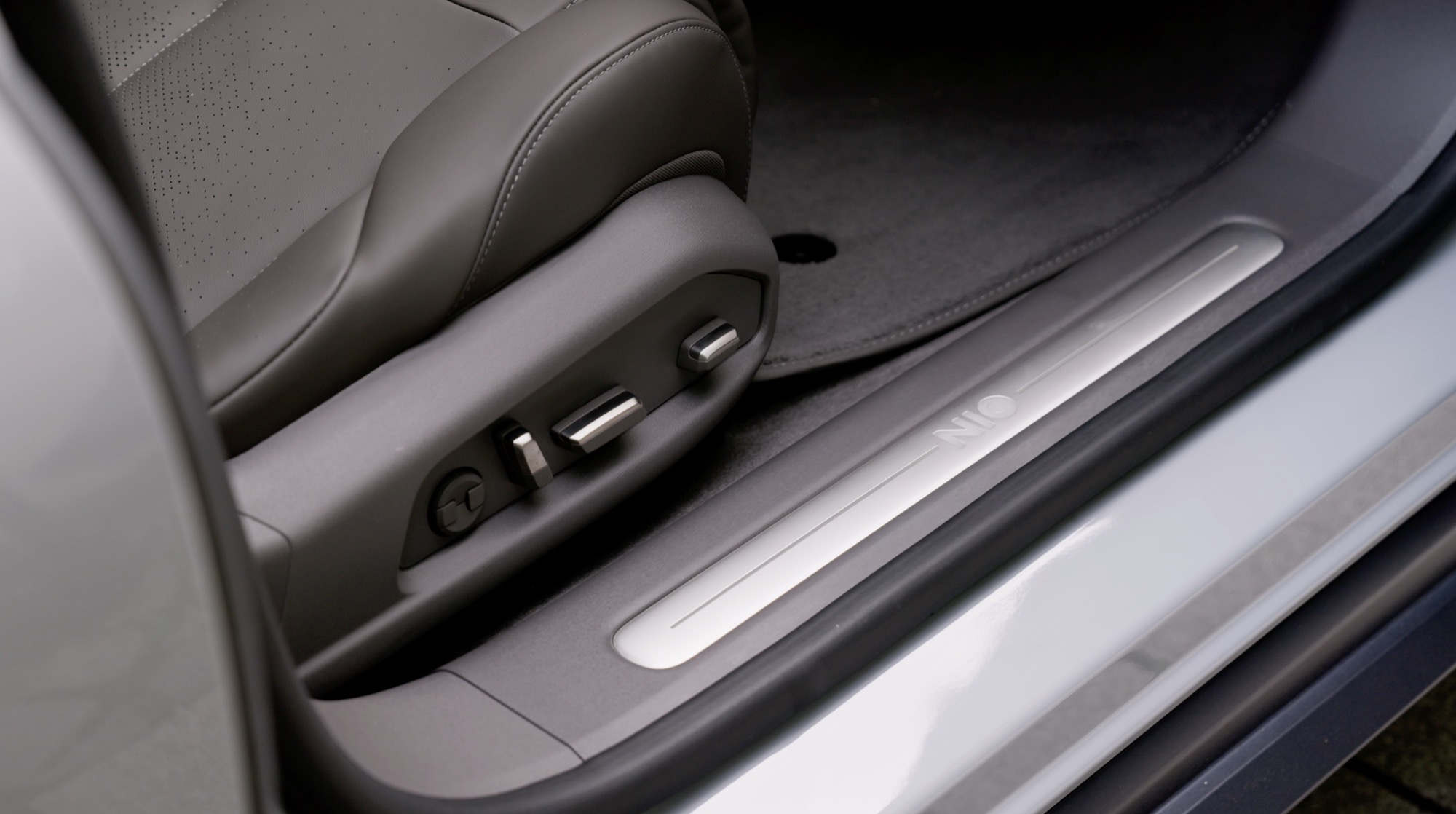
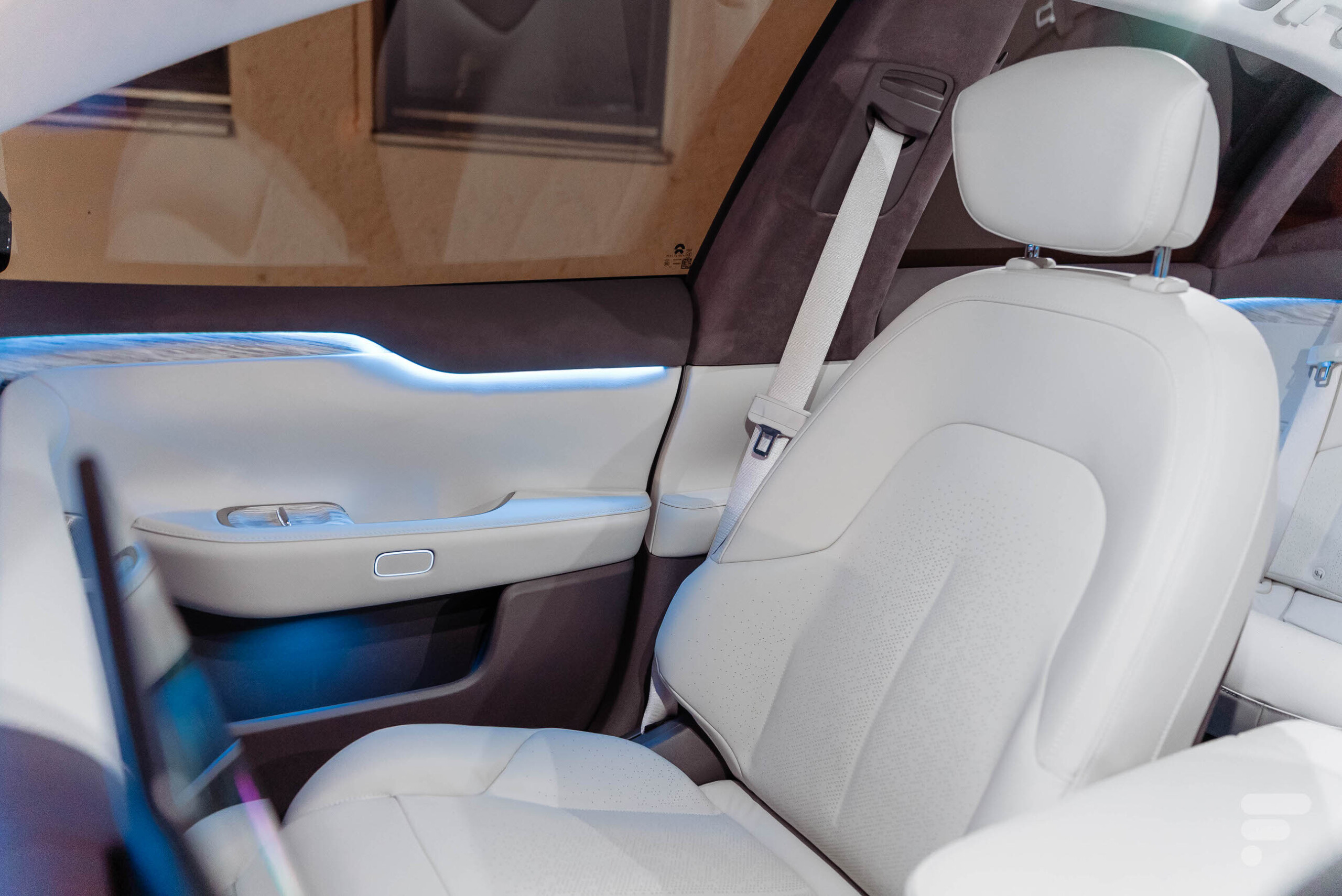

The issue here is Nio’s strength: its battery swap system. What’s the connection? It’s simple: all batteries in Nio’s various cars are exactly the same size to be compatible with each other. This constraint imposes a unique dimension and, consequently, significant height. Indeed, Nio cannot “fit” cells throughout the chassis as Tesla can with its structural pack. They are grouped in the middle of the car, resulting in a higher floor than in other competing models.
At the front, there are many storage compartments, but surprisingly, the car does not have a glove box. Instead, there are storage spaces in the doors and a center armrest that offers good depth but no compartment. It is difficult to access the bottom if the storage is cluttered. An interesting feature: the central armrest can be locked.
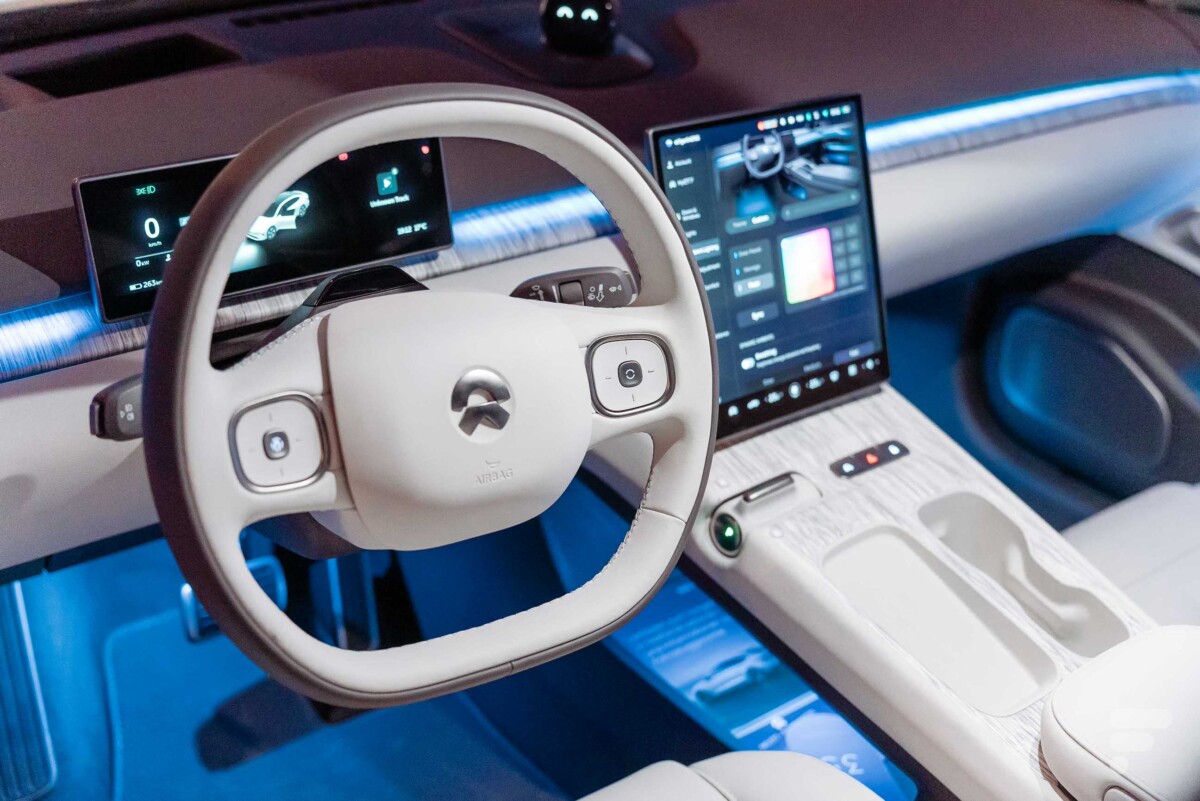
Under the floating armrest, it is possible to store larger items. On the central console, two small water bottles can fit. However, European or American-sized water bottles are not welcome, as they are too large.
Let’s continue with storage, addressing a sore point: the trunk. Or rather, the lack of trunk space. Despite the car’s length, there is no frunk (front trunk), and the rear trunk offers only 364 liters of storage. The rear seats do not even fold down to increase cargo space. There is a compartment under the trunk, but it is impossible to store a charging cable there. Disappointing.
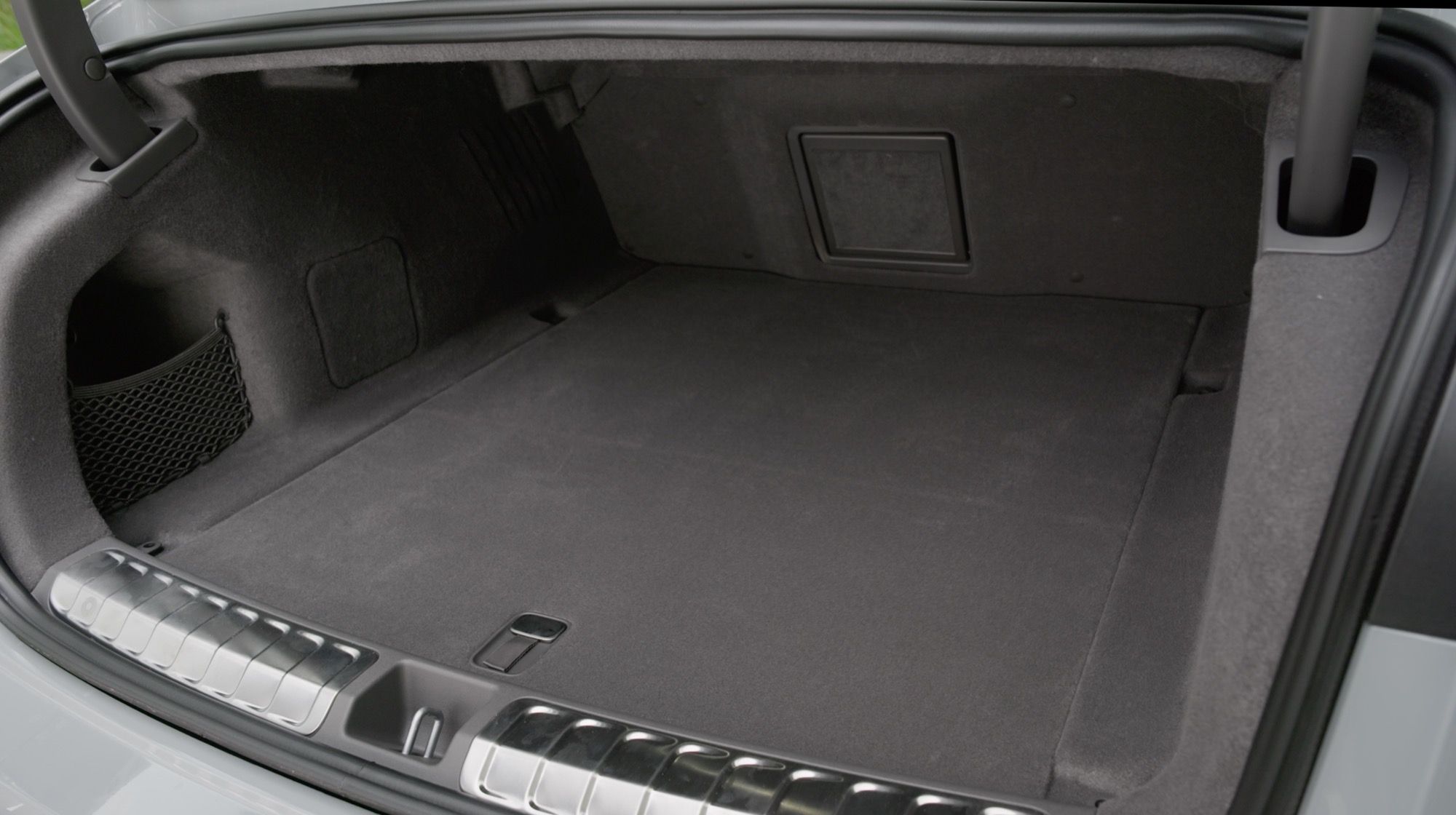

The interior ambiance is hushed but somewhat minimalist. It sits between a Tesla and a Mercedes. The air vents are invisible, as they use the same system as the American manufacturer, with a horizontal blade that diffuses air into the cabin. The central screen then adjusts the direction of the airflow, exactly like in a Tesla.

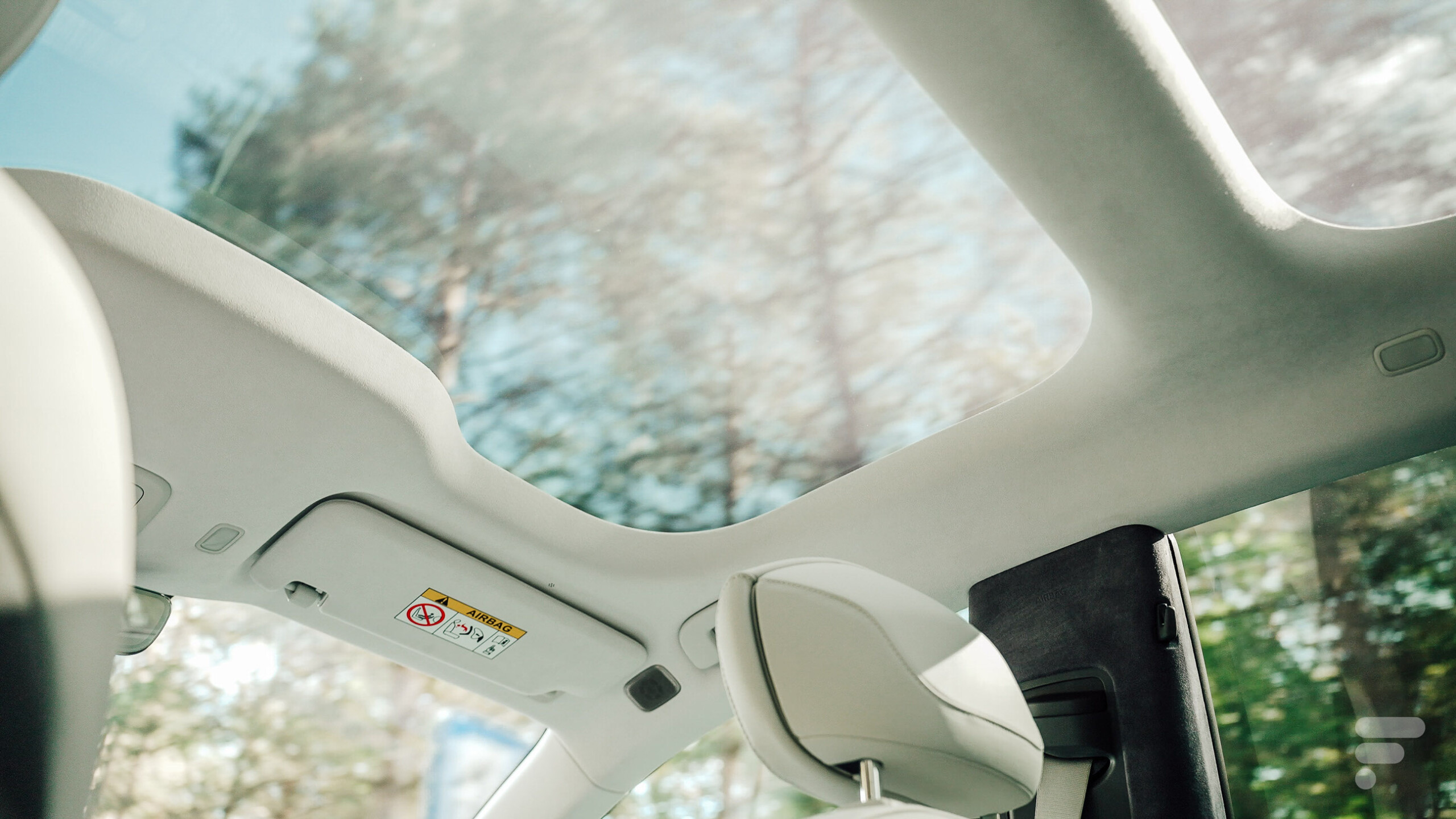
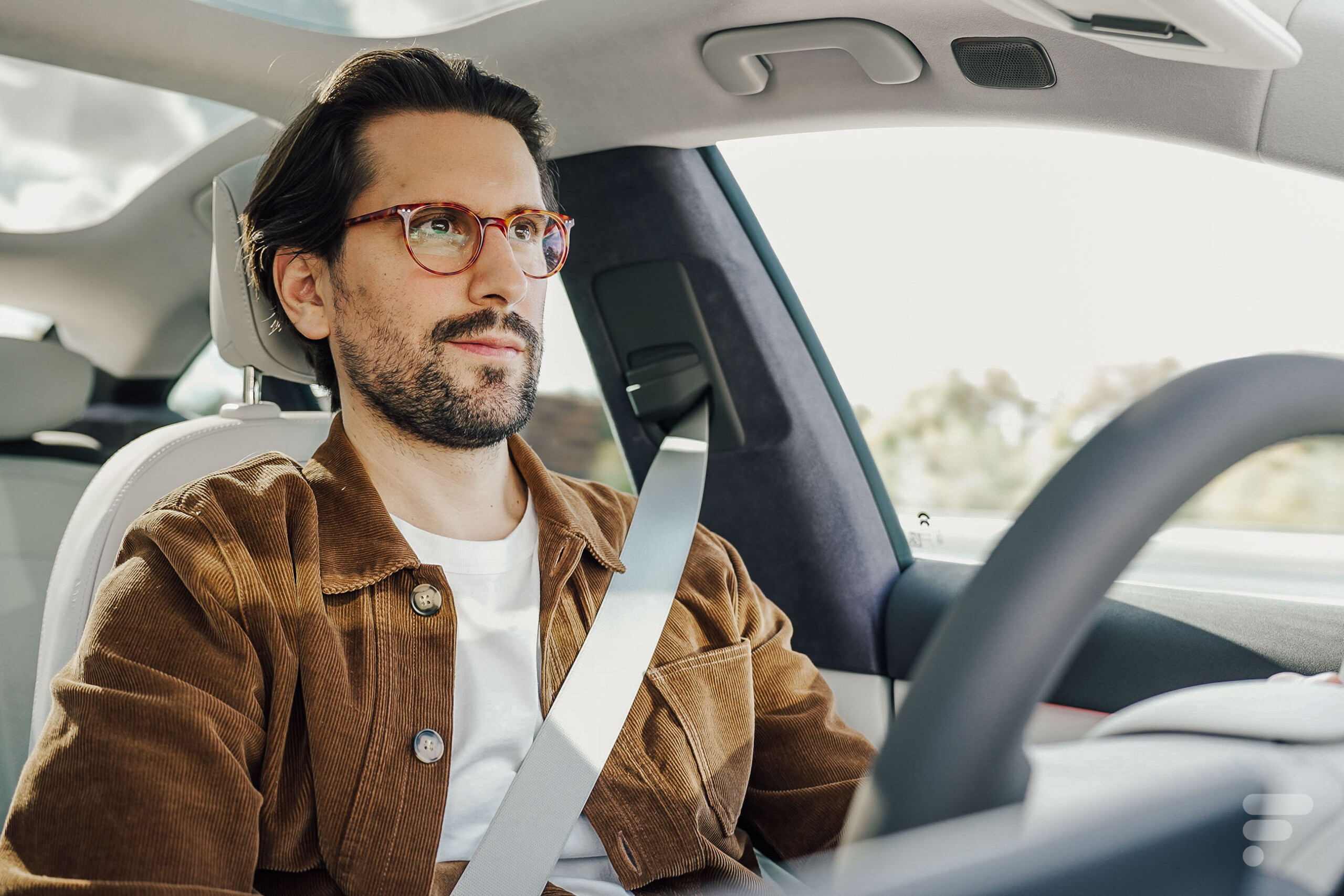
The interior lighting is also carefully designed, with RGB LEDs throughout the cabin (in three different zones) that can be adjusted to a fixed or dynamic color among 256 options. If you want a nightclub-like atmosphere, the color can change to the rhythm of the music.
The finishes and materials used inside the cabin are of high quality. However, the light wood in our test model looked like plastic, even though it is genuinely chosen and carefully crafted by Nio’s teams. A pity.
Infotainment: a comprehensive system, maybe too much
This is an exciting aspect, particularly in allowing Nio to move closer to Tesla for various reasons. The first is the complete absence of Android Auto and Apple CarPlay. You will have to rely on Nio’s ecosystem (limited in Europe).
The 12.8-inch vertical 4/3 format AMOLED central screen offers a convincing infotainment experience with the Banyan system. The GPS is very legible (although our test model suffered from imprecise geolocation), and the 360-degree camera system is impressive during maneuvers: it’s impossible to miss or collide with urban furniture given the detailed and precise images from the 11 cameras around the car.
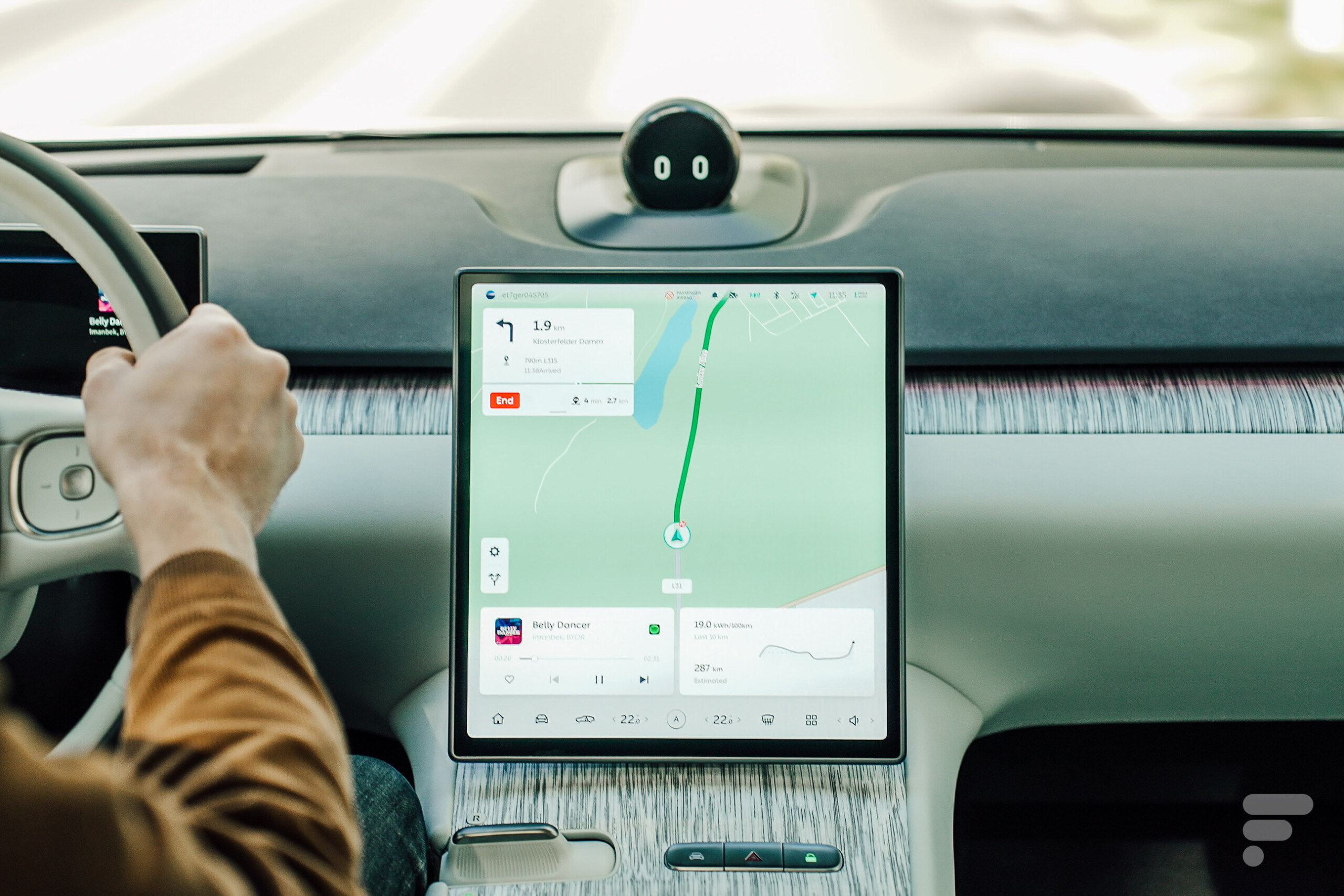
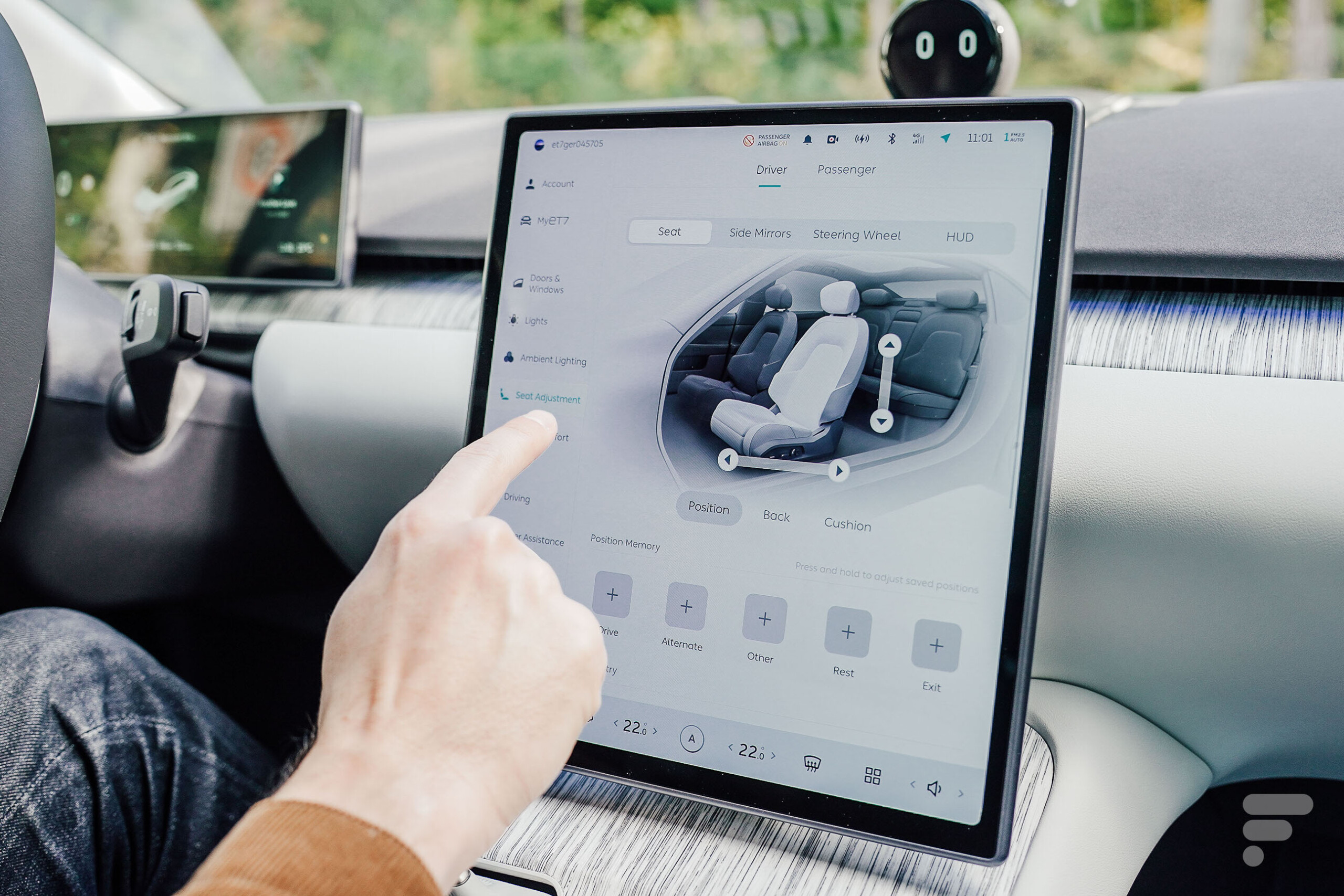
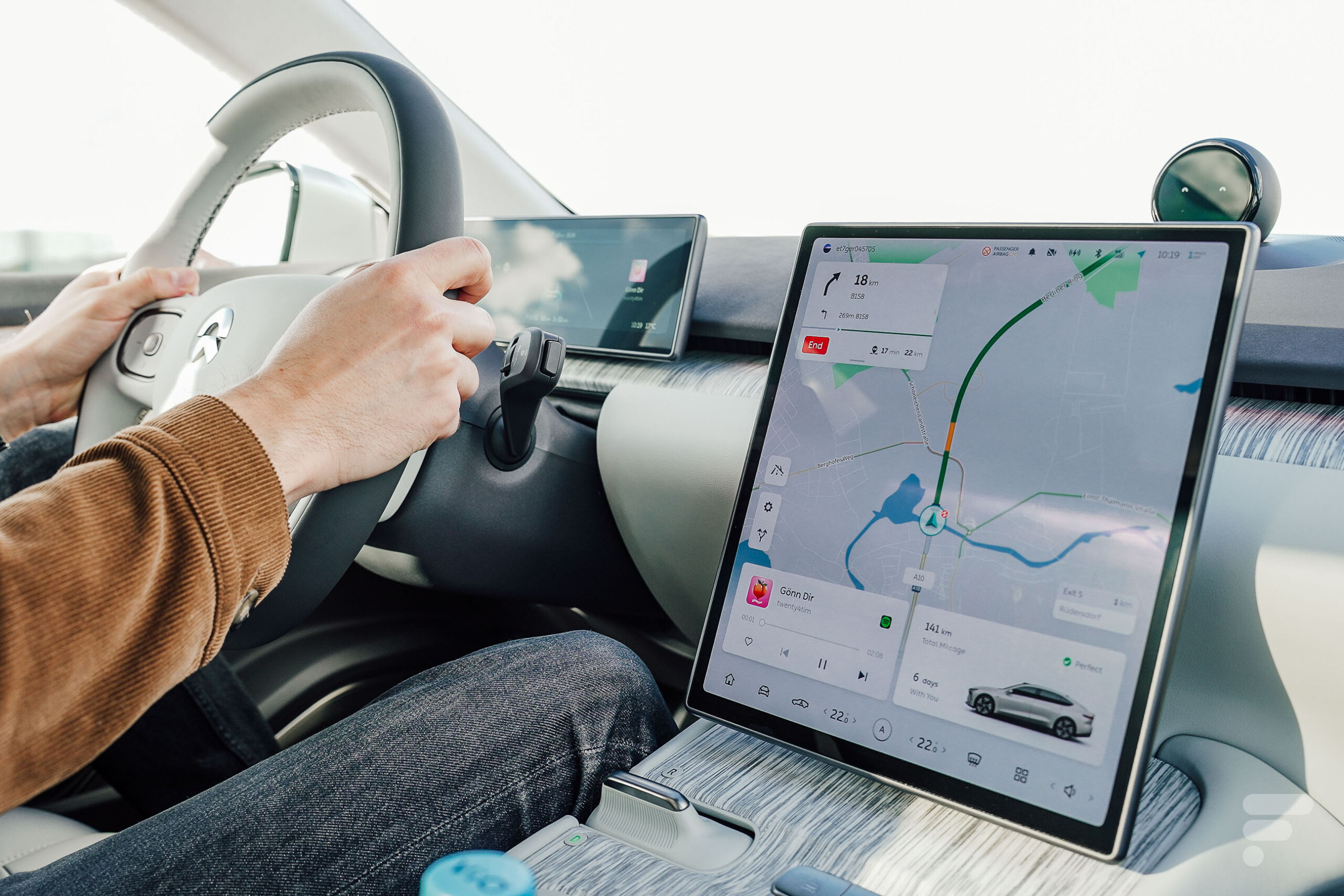
The 3rd generation Nio interface is ultra-fluid and responsive, thanks to the Qualcomm Snapdragon inside the vehicle. Even the 360-degree view, which displays real-time feeds from the various 8 and 3-megapixel cameras, is smooth. The Nvidia Orin X platform, with four processors that also support radars, ultrasonic sensors, and LiDAR for autonomous driving, is much appreciated. The total power reaches 1,016 TOPS compared to 144 in Tesla.
As with the American manufacturer, there are few physical buttons, as most adjustments are made through touch controls, particularly for ventilation management. Wipers and headlight management are still operated with stalks behind the steering wheel. Camping and pet modes are also available to keep the ventilation system on even when the car is “off.”
As a Chinese car, it features some unique elements that may not sit well with Western audiences. First is facial recognition, which can unlock the glove box or adjust the seat, steering wheel, and mirror positions according to the driver.

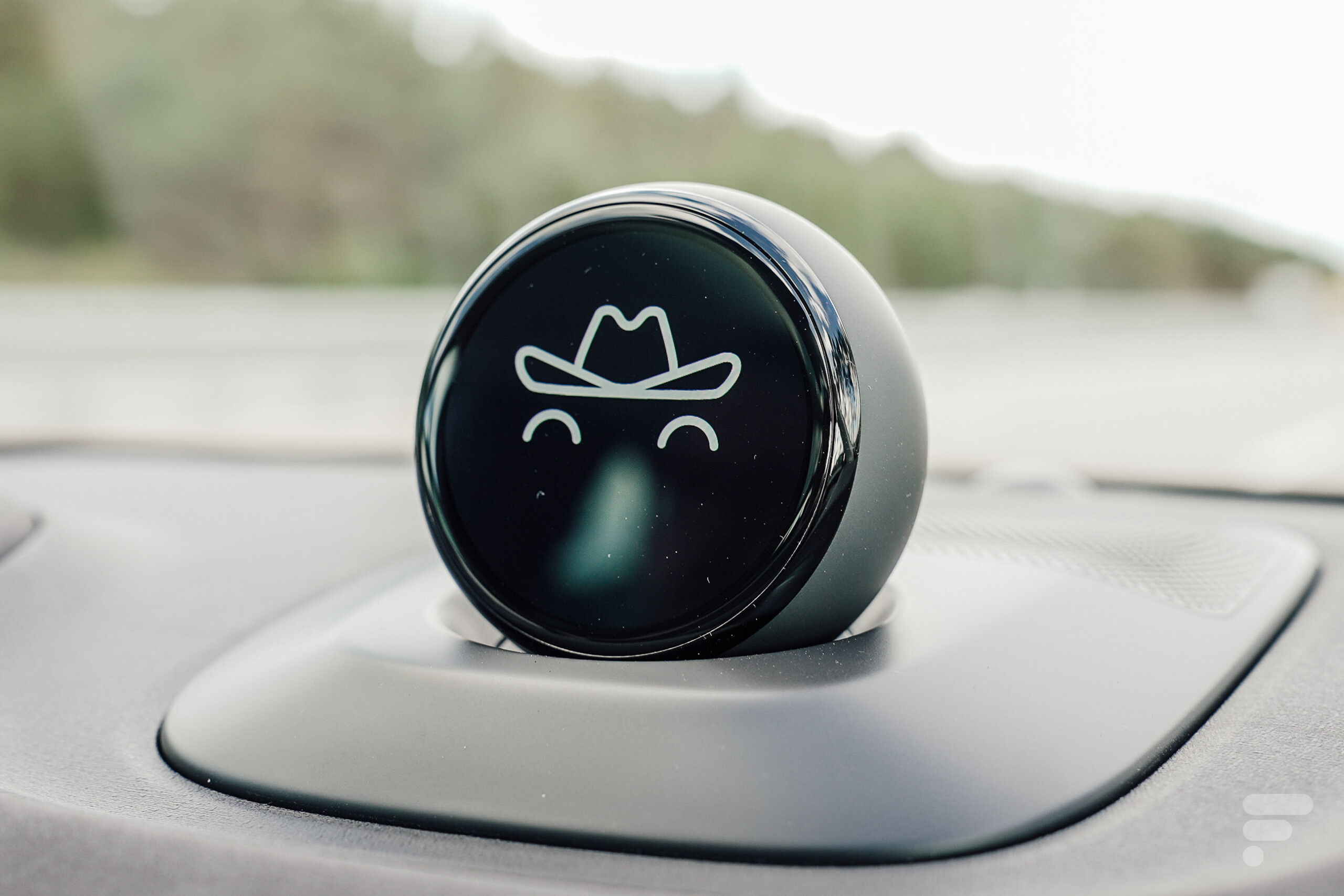
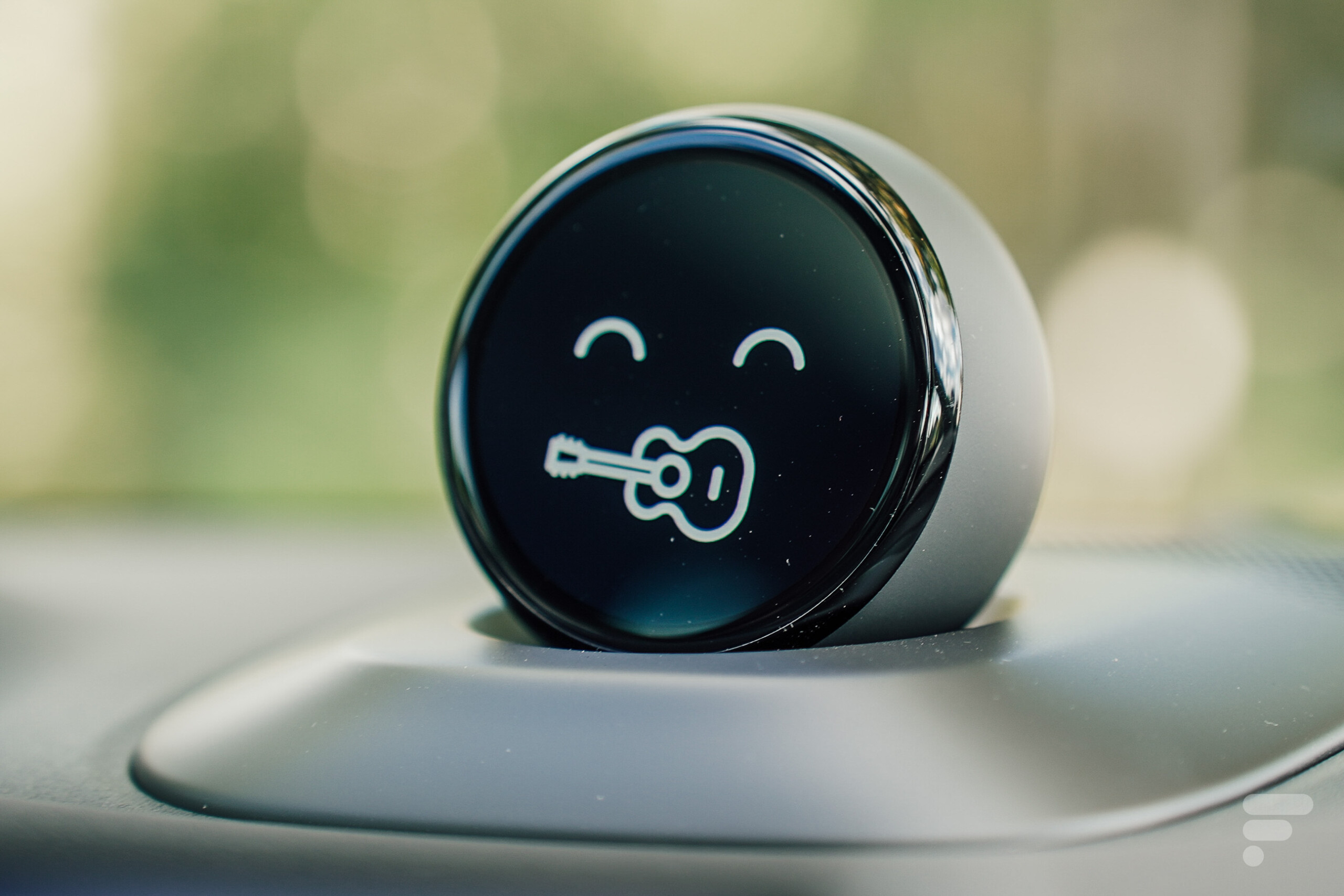
The other, more divisive element is the Nomi Mate 2.0 personal assistant. It takes the form of a small virtual character, placed in the center of the dashboard. In practice, it is a motorized ball with a “face” or rather eyes, displayed on a 2.18-inch AMOLED screen, and a strong personality.
Four microphones are positioned in the car so that Nomi can identify who is speaking. For example, when the rear right passenger says, “Hey Nomi, open the window,” the car will open the corresponding window. And of course, Nomi will turn towards the passenger and vocally confirm the request.
Where we think it goes a bit too far is that Nomi cannot be deactivated. You can ask her to stop listening (she then puts on headphones in a well-executed animation), but she still monitors the car’s activities. When you drop off a passenger, she will turn towards them and wave goodbye.
While it’s cute, it quickly becomes annoying. Fortunately, in a few months, you will be able to order Nomi Halo, which takes the form of a pebble placed on the dashboard, without any “face” or overly invasive actions.
Another weak point of the system is the lack of satellite view mapping. It’s a minor detail, but on such a beautiful central screen, it’s a shame to settle for a plain map background.
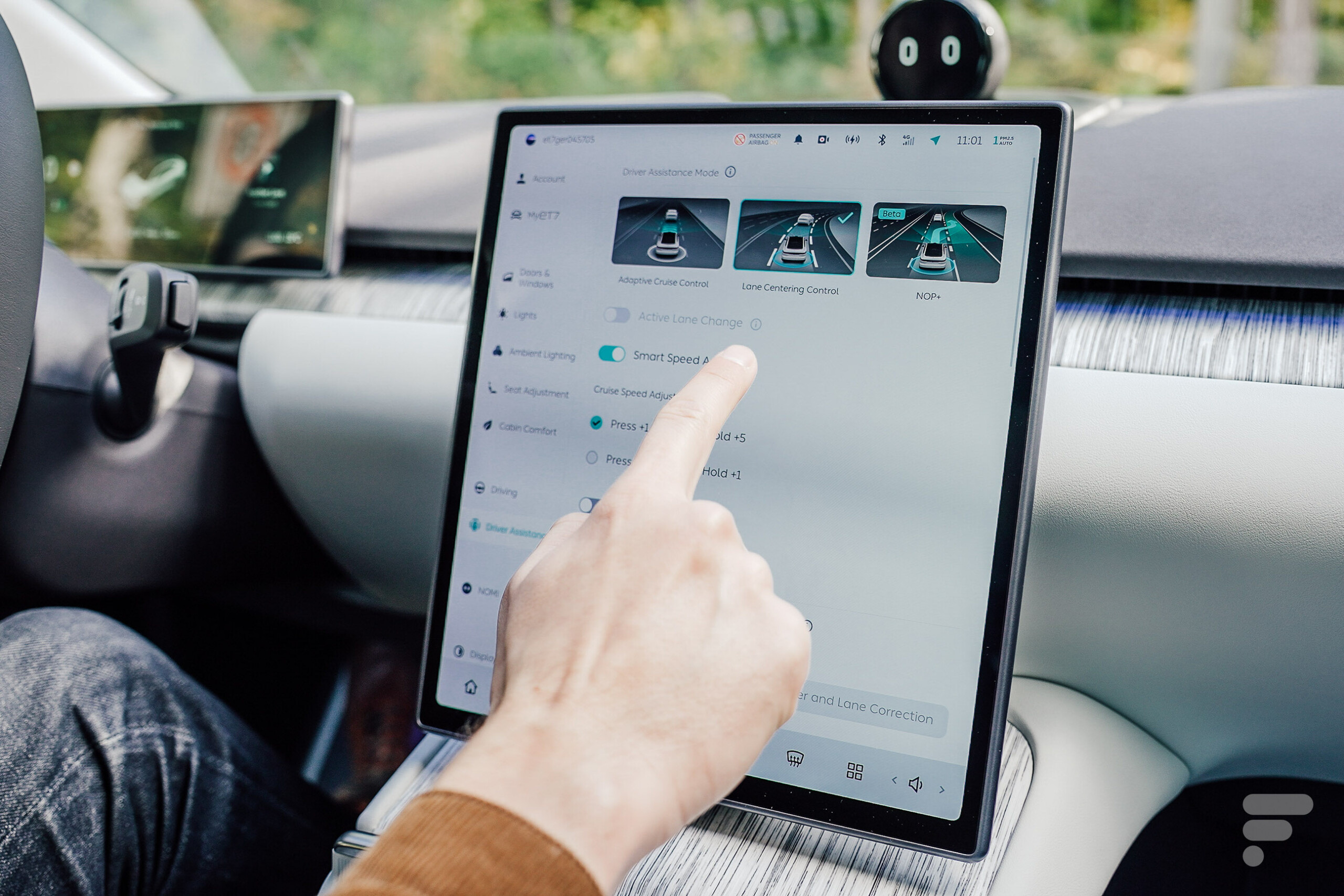
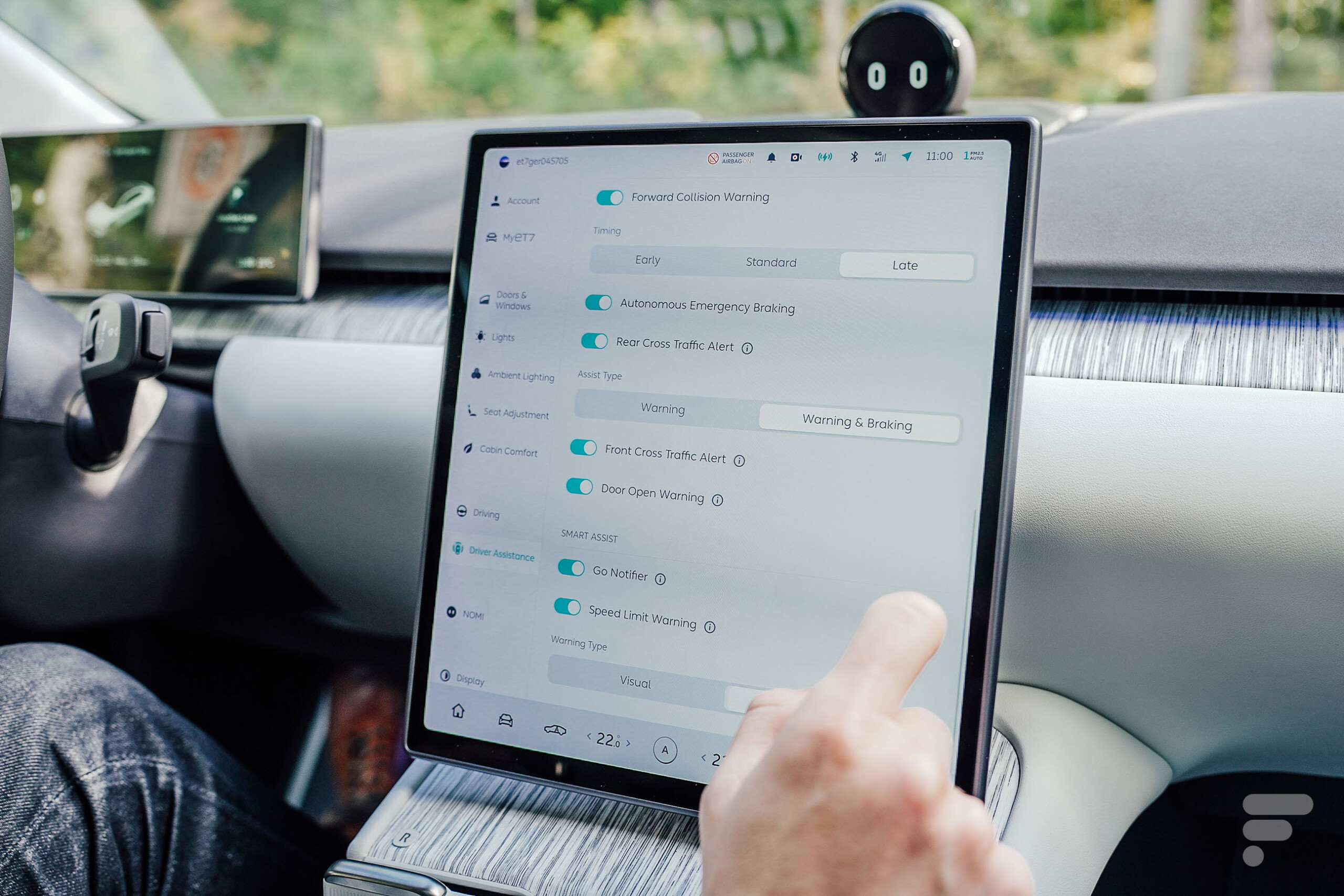
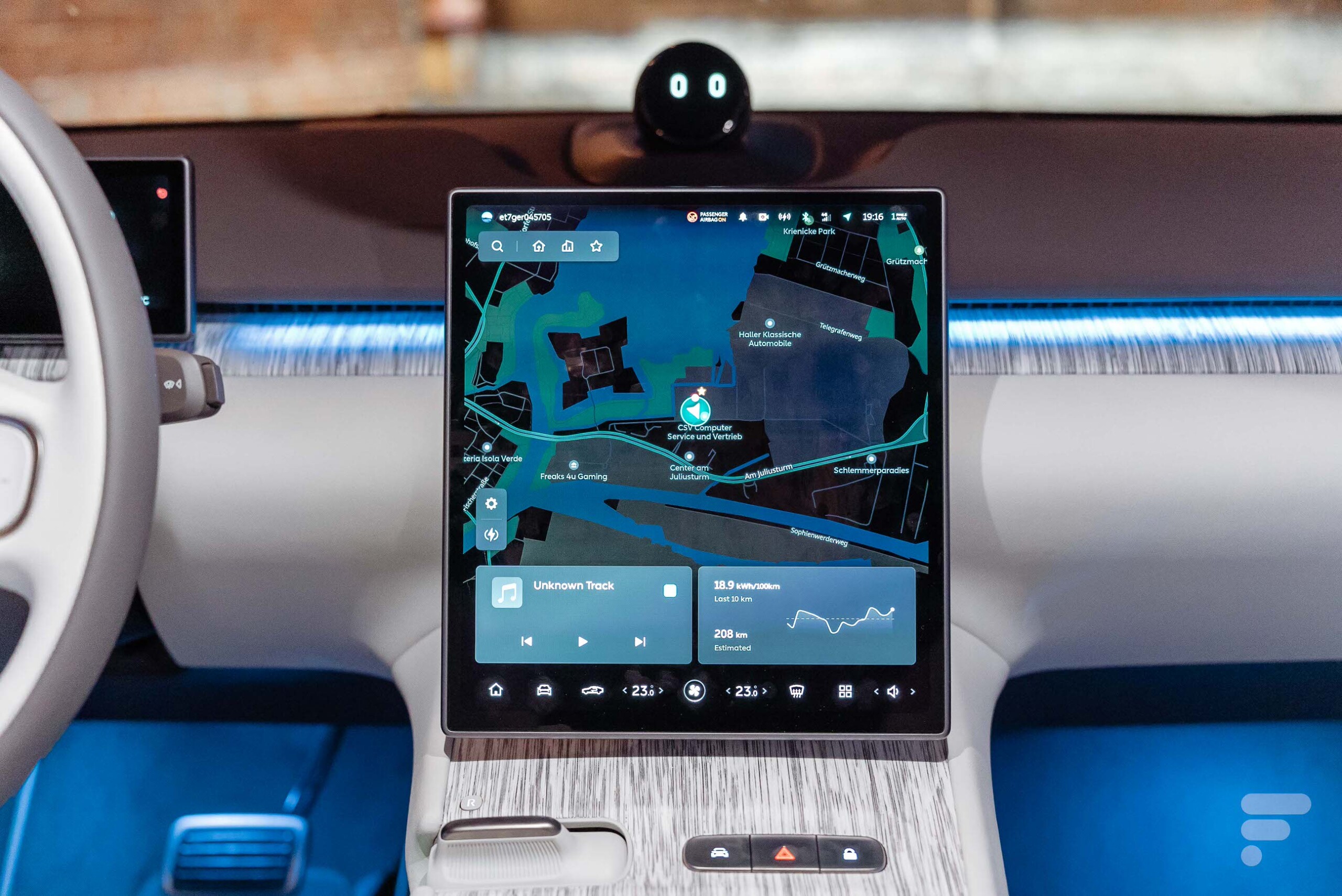
Want proof that Nio is a brand for geeks? Check this out: it’s possible to create task automation actions. For example, if you want the seat in front of the rear right passenger to move forward (if empty), the massage to activate, and music to start when they sit down, you can do that.
The 10.2-inch (mini LED) screen behind the steering wheel serves as the instrument cluster, displaying essential information such as speed, remaining range, GPS directions, and instant consumption. Unfortunately, this display cannot be customized, which is a shame.
Of course, the system can be updated remotely via the internet (OTA). Nio announces updates every one to three months for the main system and more frequently for the infotainment system.
Like Tesla, you can record videos from the cameras to use as a dashcam. Nio goes further by allowing you to apply a HUD that displays real-time timestamp, speed, and vehicle status (acceleration or braking).
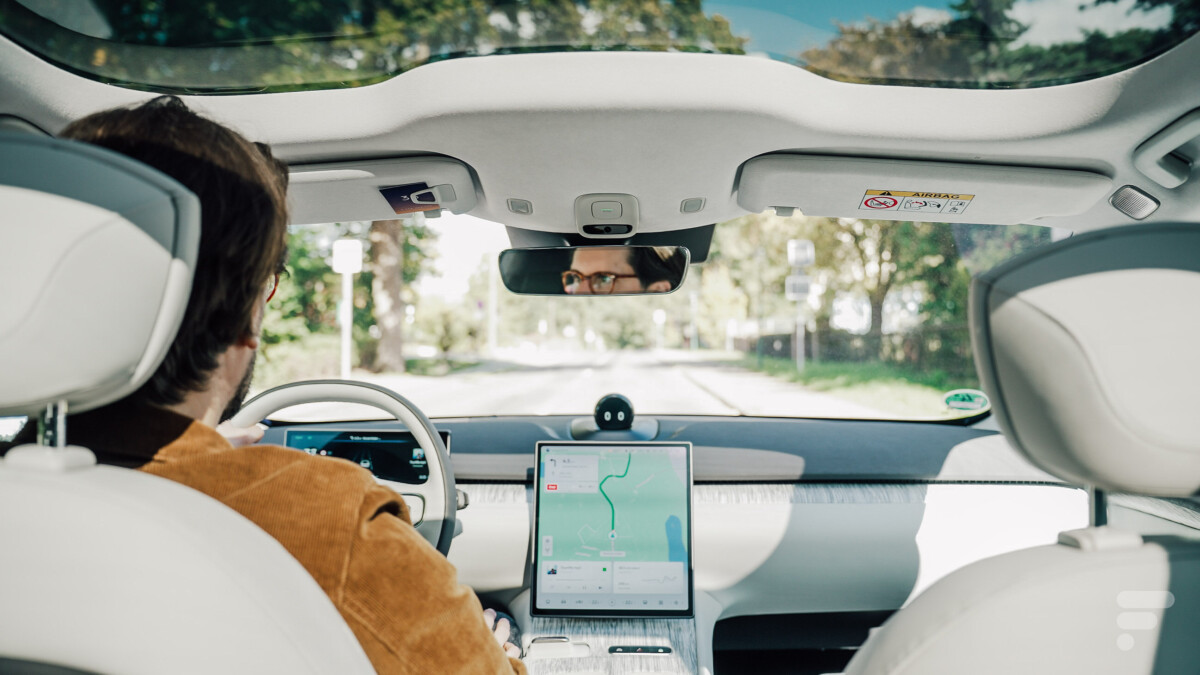
The car also includes a route planner that appears quite efficient. It integrates many third-party charging stations in Europe and six battery swap stations in Germany and Norway.
When the driver enters a destination beyond the vehicle’s actual range, the system suggests one or more routes, each with the number of charging stops, downtime, associated cost, and remaining charge upon arrival. It seems obvious, but many electric vehicle manufacturers don’t offer such a system.
You’ll also find Spotify, Tidal, weather, and even a Photos app. It’s essentially a gallery that includes both dashcam-recorded videos and selfies taken with the cabin camera. Creepy? No, but culturally unsuitable for Europe.
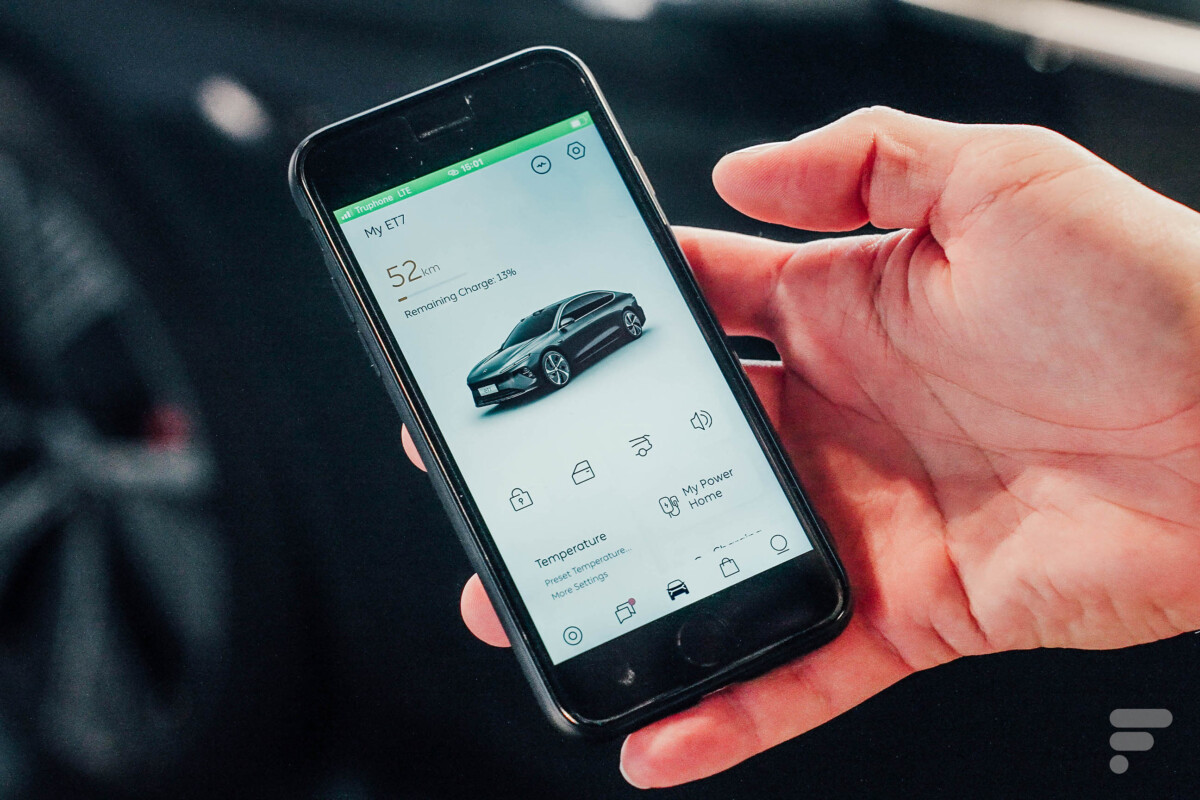
A quick word on the iOS and Android mobile app that allows remote charging initiation and activating commands such as the horn, door and window opening. You can also precondition the cabin to be at the right temperature when you reach the car.
Want more? Nio doesn’t stop there, selling virtual reality glasses that connect to the car’s USB-C port. This allows passengers to enjoy a 150-inch virtual screen to watch movies during the trip. An algorithm reduces motion sickness by “stabilizing” the projected image.
We tested the feature while stationary, and the image was very stable despite head or body movements. The car itself is somewhat of a home theater, with a 1,000-watt Dolby Atmos 7.1.4 sound system, including 23 speakers for excellent audio quality.
Autonomous driving: room for improvement
Do you love driving aids, especially those that take over part of the driving on highways and prevent fender benders in the city? This Nio E7 is for you. It integrates 22 different driving assistance features.
Of course, you’ll find adaptive cruise control and lane-keeping assist, allowing for Level 2 autonomous driving. But there are also more exotic aids, like the “Go Notifier,” which alerts you if the car in front of you at a traffic light has moved and you’re still stopped, lost in thought.
A head-up display is also included, mainly useful for speed reading, as navigation instructions are not very readable with this system. The parking assistance is highly efficient, even excellent.
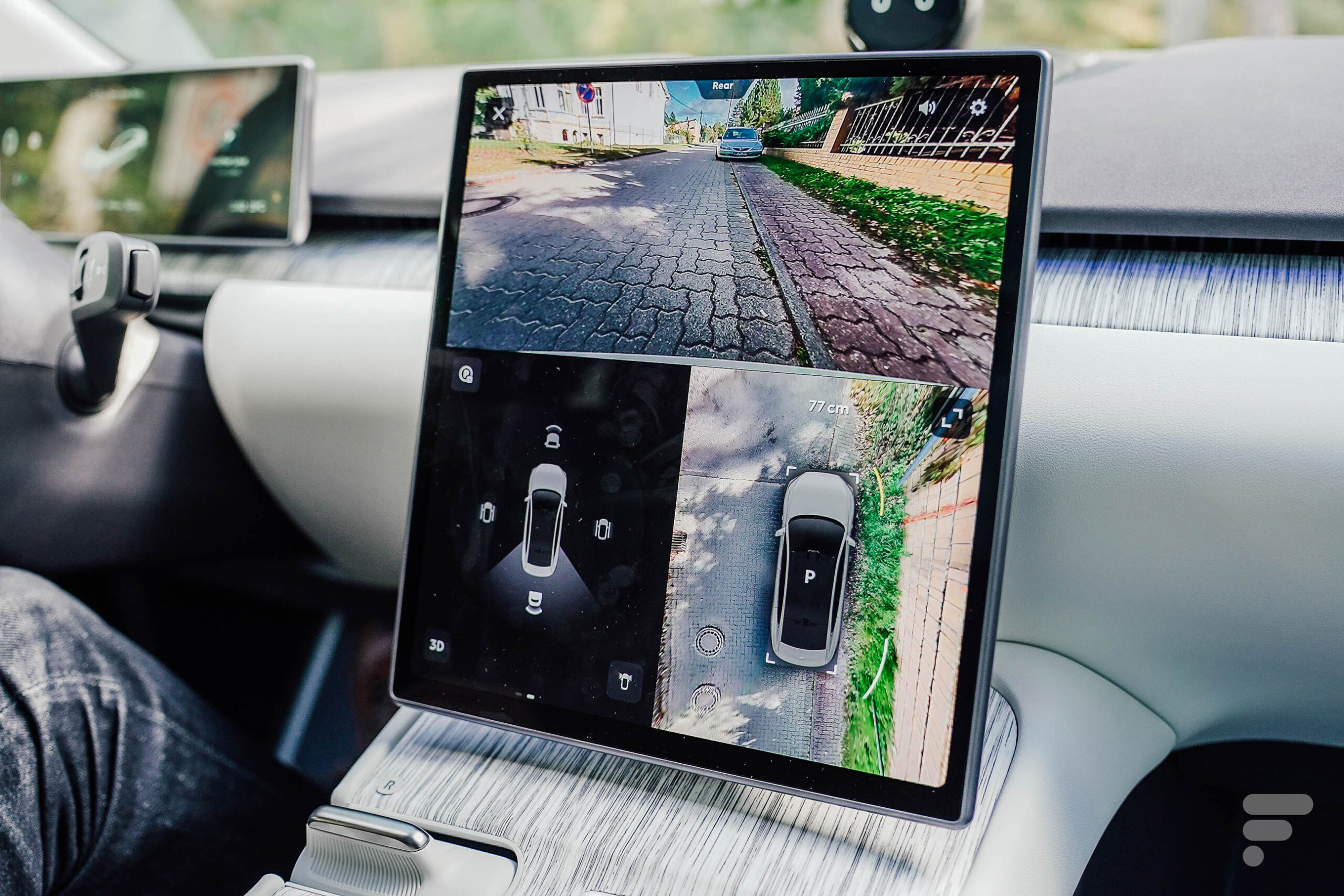
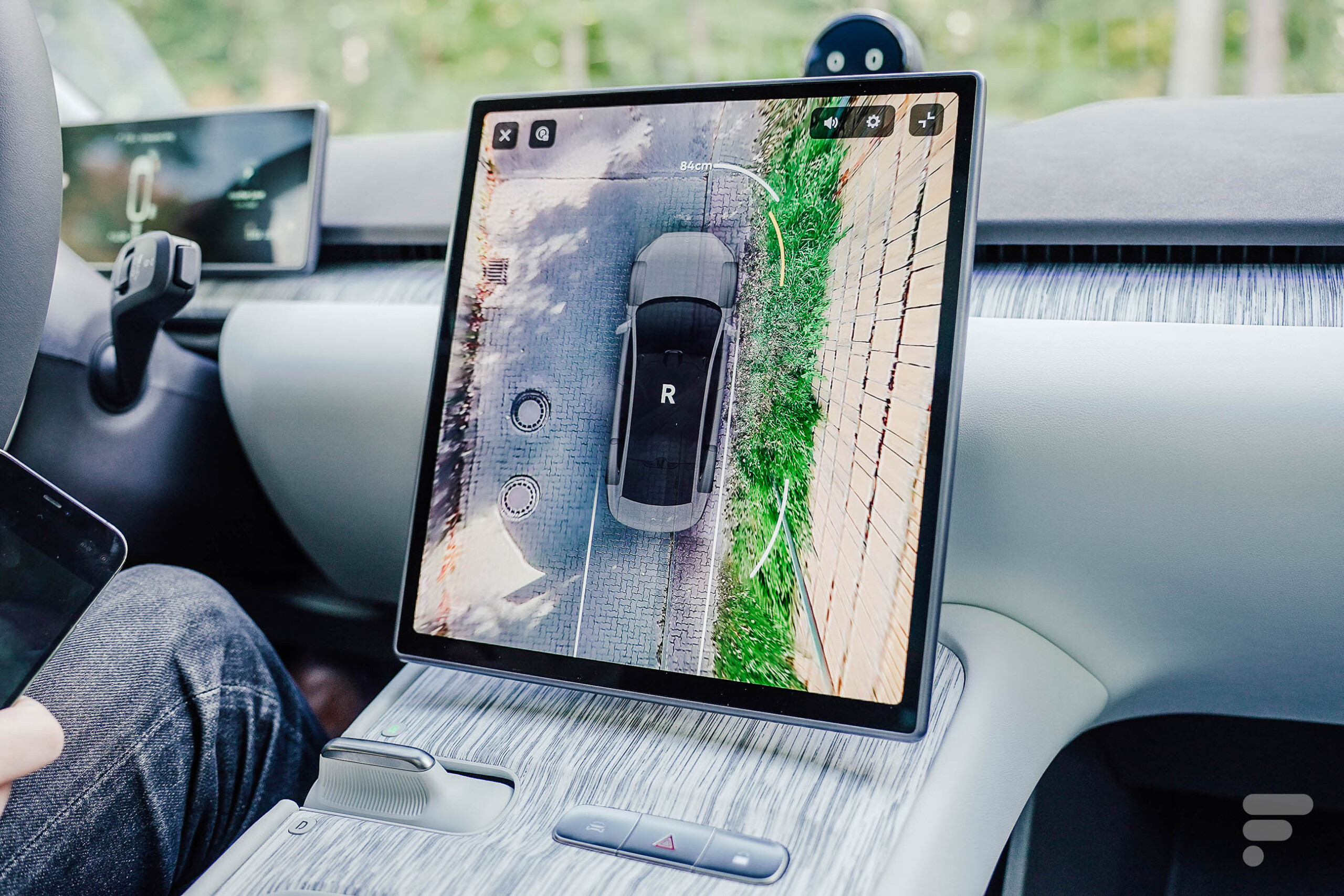
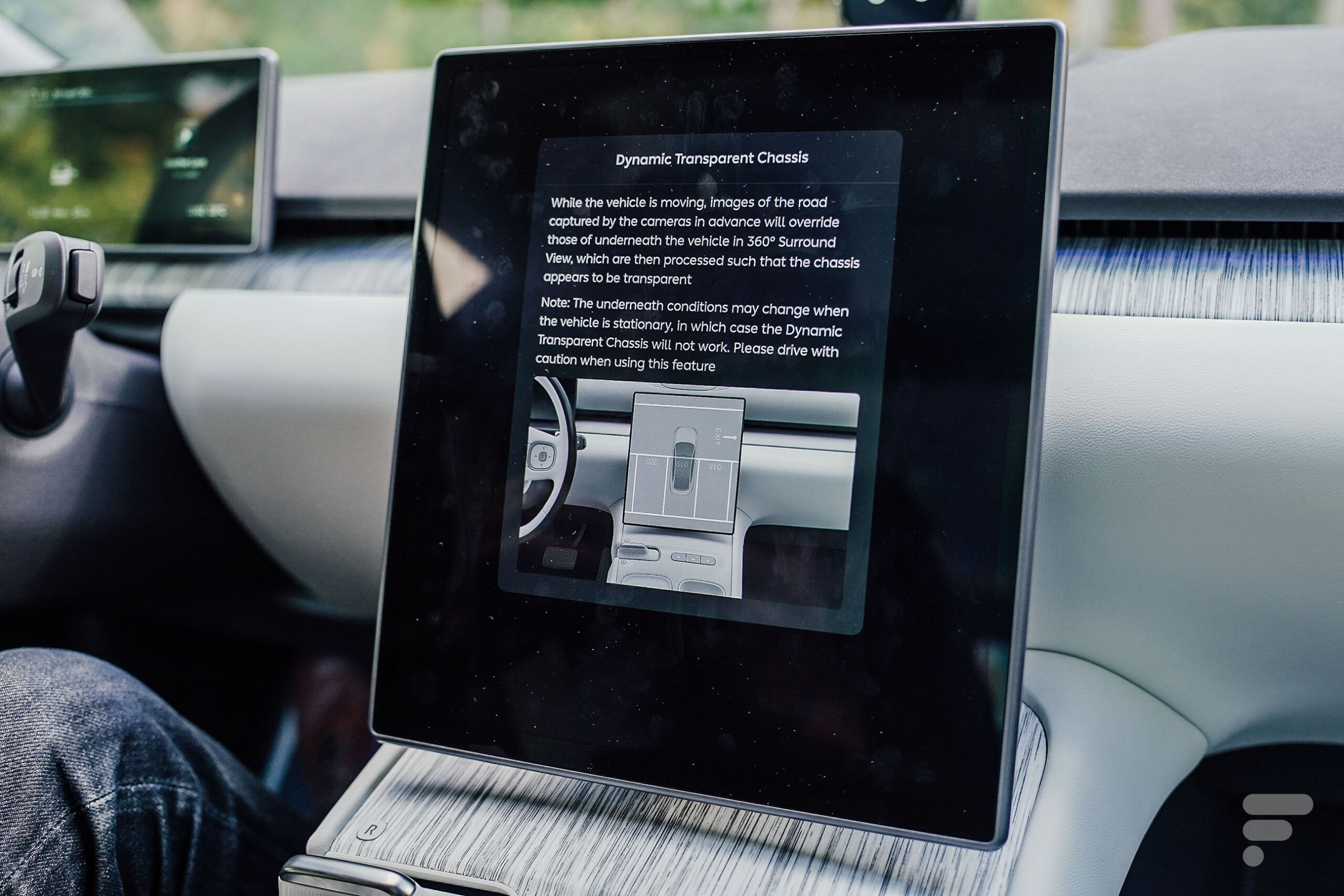
The adaptive cruise control works perfectly, thanks to the LiDAR and rooftop cameras that provide long-range and precise vision. However, lane-keeping assist is somewhat erratic and inconsistent in its behavior. At times, it perfectly centered the car in the lane, but other instances, the car seemed to zigzag within its lane, like the ball in the Pong video game.
Don’t worry, though, as this behavior may change as Nio releases updates. However, Nio lacks Tesla’s powerful data collection from years of real-world driving. Tesla has one of the world’s most powerful supercomputers (Tesla Dojo) that analyzes and uses data from all Teslas on the road to improve its Autopilot.
Moreover, Nio has integrated LiDAR into its car, while Tesla is going in the opposite direction, completely forgoing radars and recently ultrasonic sensors to focus on cameras. LiDAR is supposed to be better than cameras, with higher precision and immunity to glare from oncoming headlights.
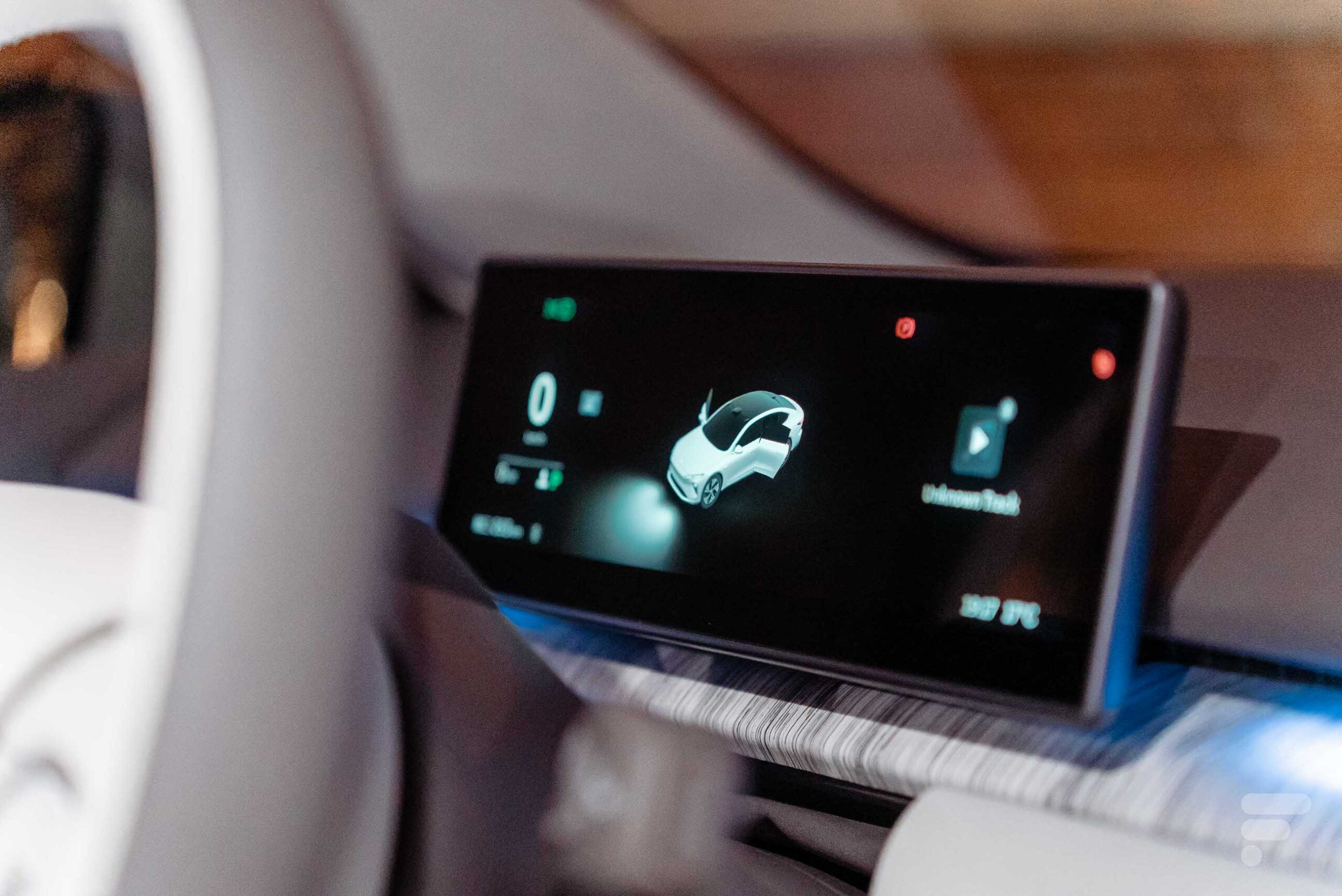
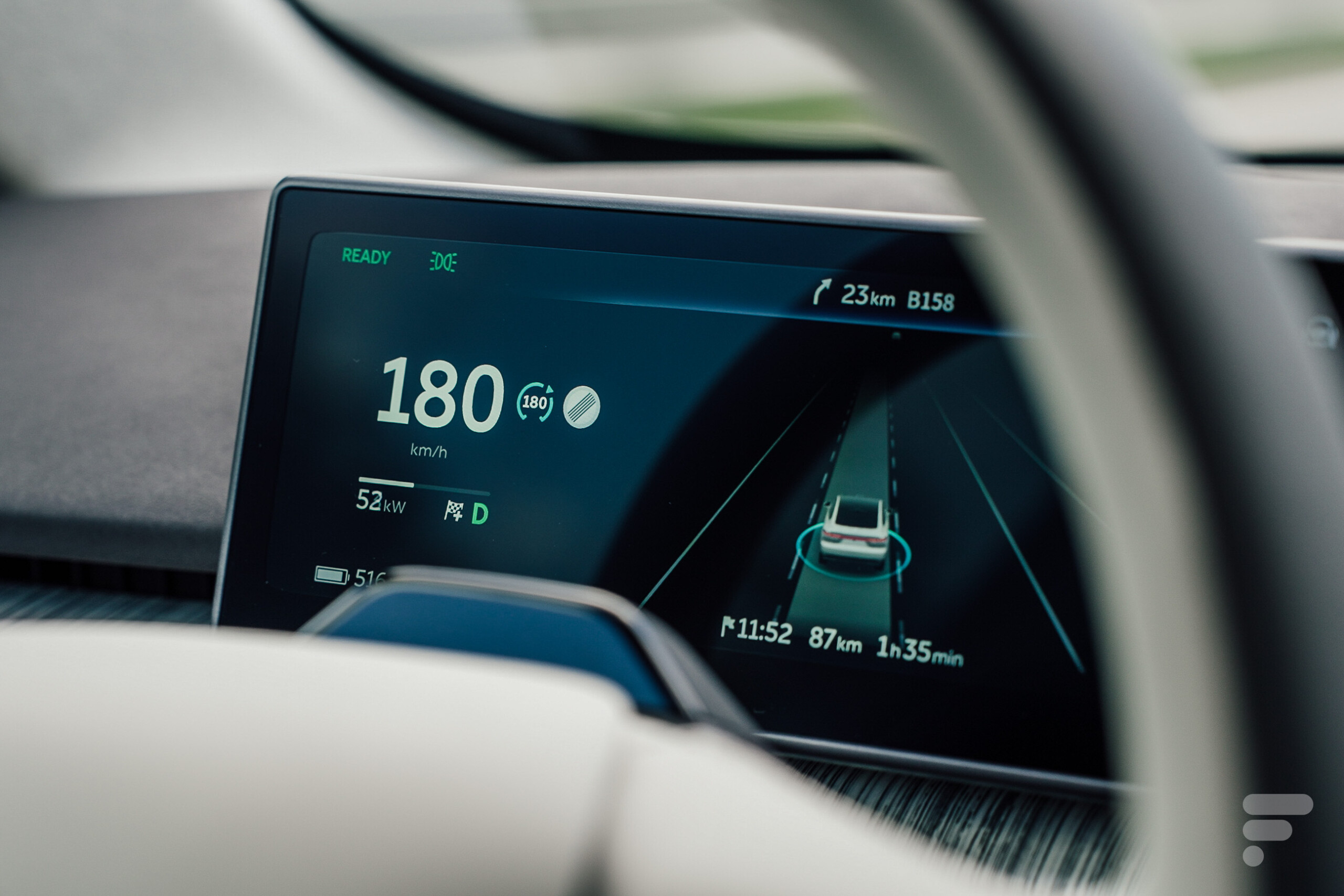
Indeed, the LiDAR seems to see far and with great precision. The instrument cluster displays a 3D image of what the cameras, radars, and LiDAR see. In central Berlin, dozens of pedestrians were individually represented on the screen at a crosswalk, whereas a Tesla would show two or three pedestrians with less precise positioning.
Unlike Tesla, which limits its Autopilot to 150 km/h (93 mph), Nio limits its system to 180 km/h (112 mph) while the car is capped at 200 km/h (124 mph). On an unrestricted section of a German highway, we tested the semi-autonomous driving at its maximum speed. It worked well, except for the instability in maintaining the center of the lane, without phantom braking or erratic slowdowns.
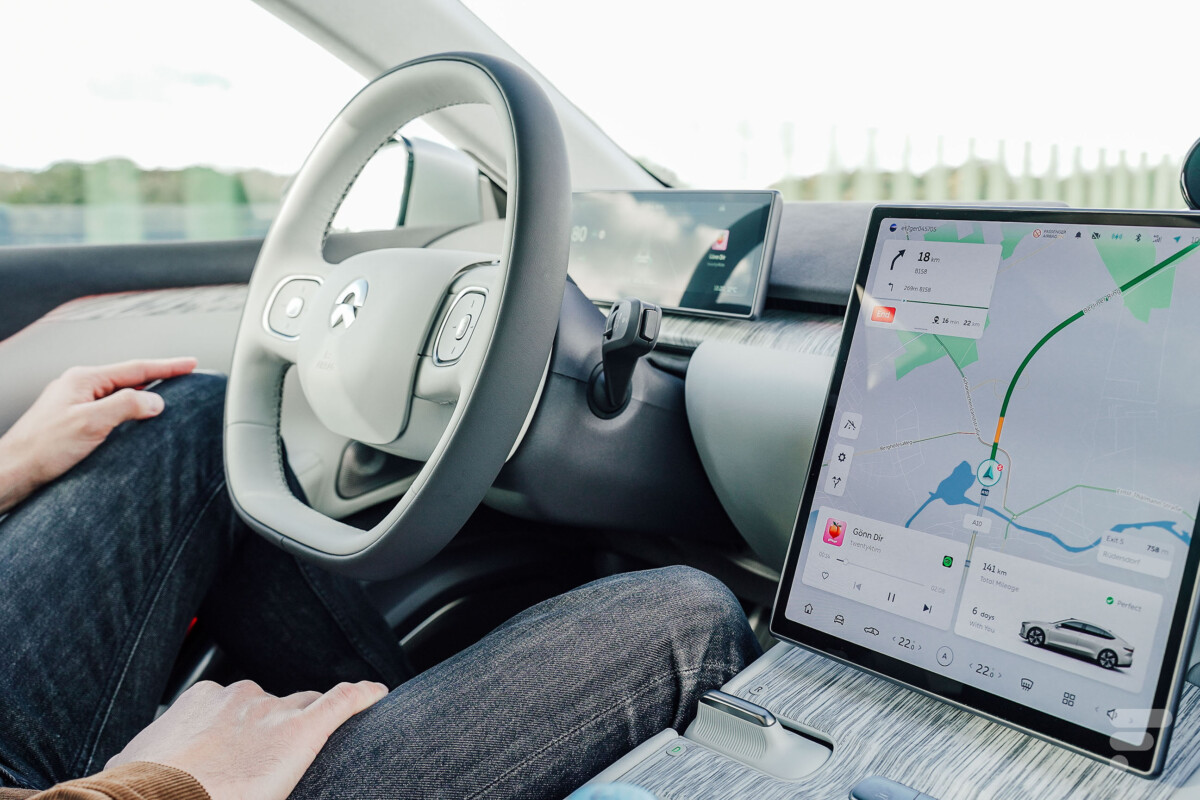
Nio doesn’t forget vulnerable road users, as the “Door Open Warning” feature warns when opening the door if a cyclist, motorcyclist, or other motorist is approaching from behind. This can save lives and car bodies in the city.
In terms of autonomous driving, the car can also be requested to perform an overtaking maneuver by activating the turn signal. The car can even go further with the NOP functionality, which we couldn’t test since it required the Chinese Nio app to unlock a tutorial.
This feature clearly copies Tesla’s Navigate on Autopilot. In Nio’s case, it’s called Navigate on Pilot, but the idea is similar: allowing the car to make decisions based on the route entered in the navigation system. The Nio ET7 can overtake, adjust its speed according to sign readings, and take highway exits, bringing it closer to Level 3 autonomous driving.
Nio has expressed its long-term goal of achieving Level 3 autonomy. However, the company is aware that its Level 2 system is not yet perfect and wants it to be fully usable on all roads (not just highways) before considering Level 3 autonomous driving deployment.
Regal comfort and high-flying performance
We’ve spent a lot of time discussing the onboard system, infotainment, and driving aids. But how does the Nio ET7 perform on the road and the track? We drove a 250 km (155 miles) loop, consisting of highways, expressways, rural roads, and urban streets. Throughout these 250 km, we were pleasantly surprised by the car’s comfort.
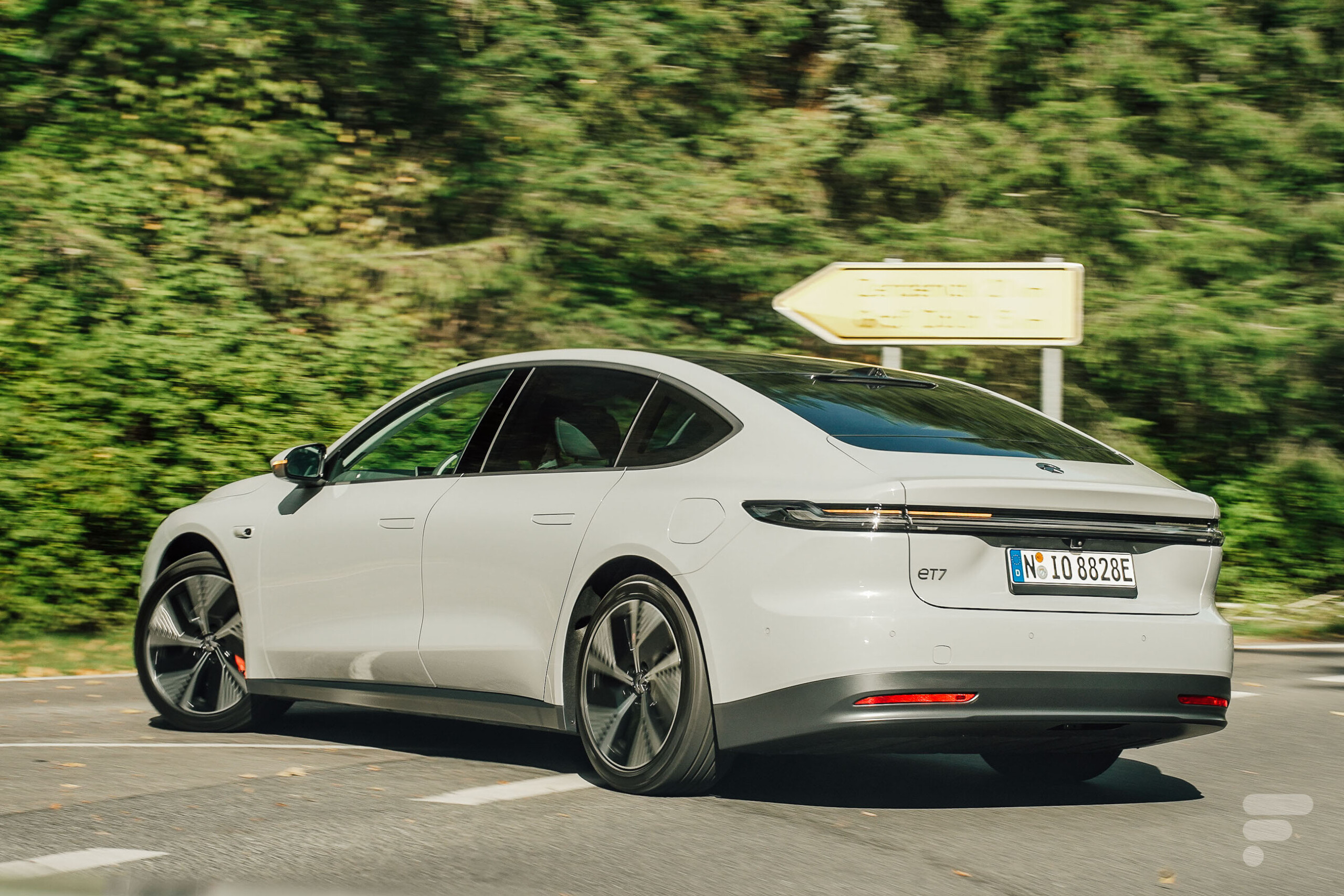
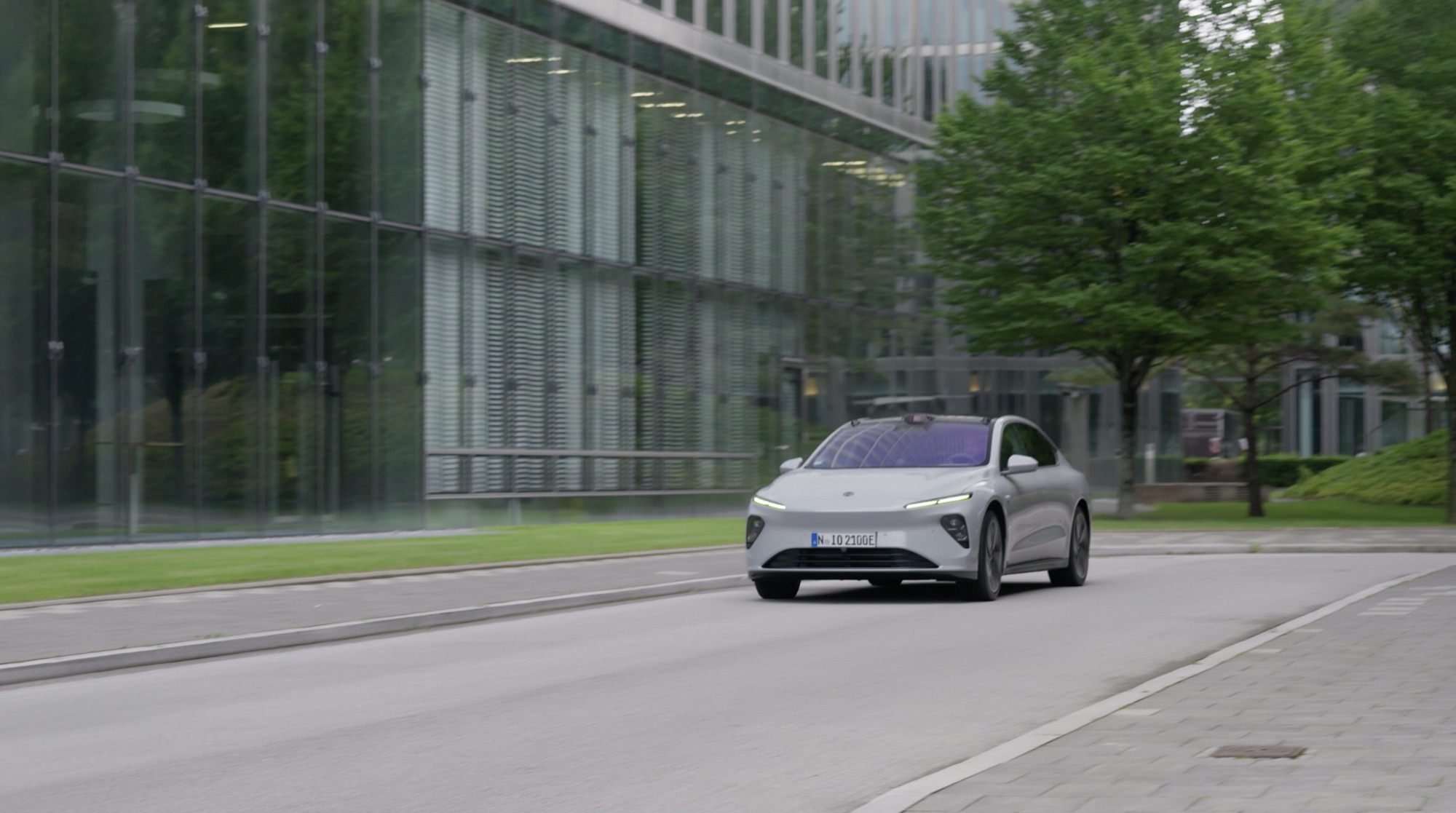
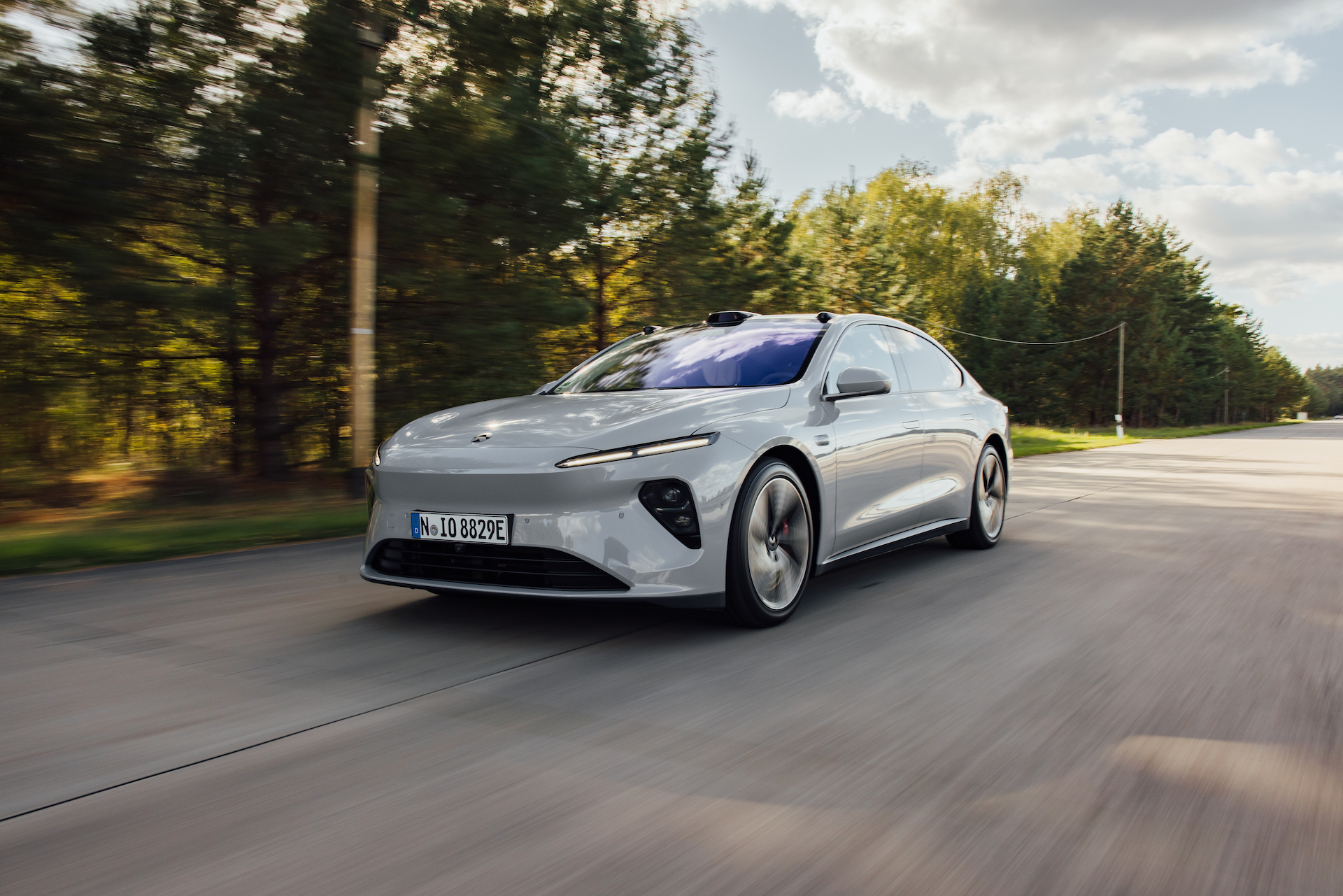
Its electronically adjustable air suspension system plays a significant role in this. Road imperfections are smoothed out, even with 20-inch wheels, maybe not as much as in a Citroën or Mercedes, but the feeling of a magic carpet ride is real.
Of course, it’s possible to adjust the suspension by changing the driving mode. Sport mode results in stiffer, more direct suspension, while comfort mode provides a softer, more cushioned feel.
The acceleration is impressive. Despite its 2.4-ton weight, the Nio ET7 is propelled by 480 kW (652 hp) of power and an impressive 850 Nm of torque. It goes from 0 to 100 km/h (0-62 mph) in 3.8 seconds (with two passengers and luggage), and its pickup is excellent. There is a slight latency in the accelerator pedal, but you’ll literally push your passengers back into their seats if you have a heavy foot.

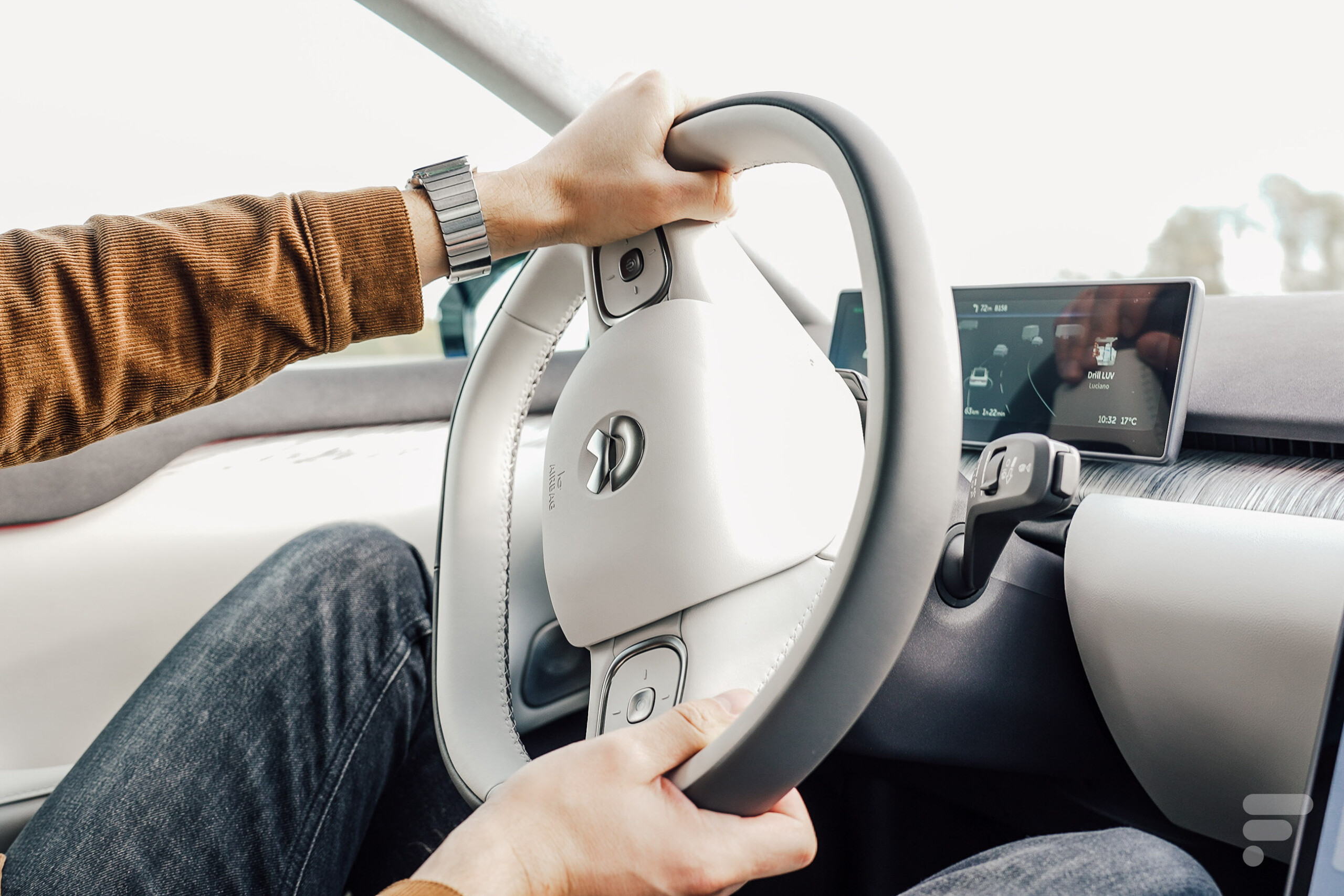
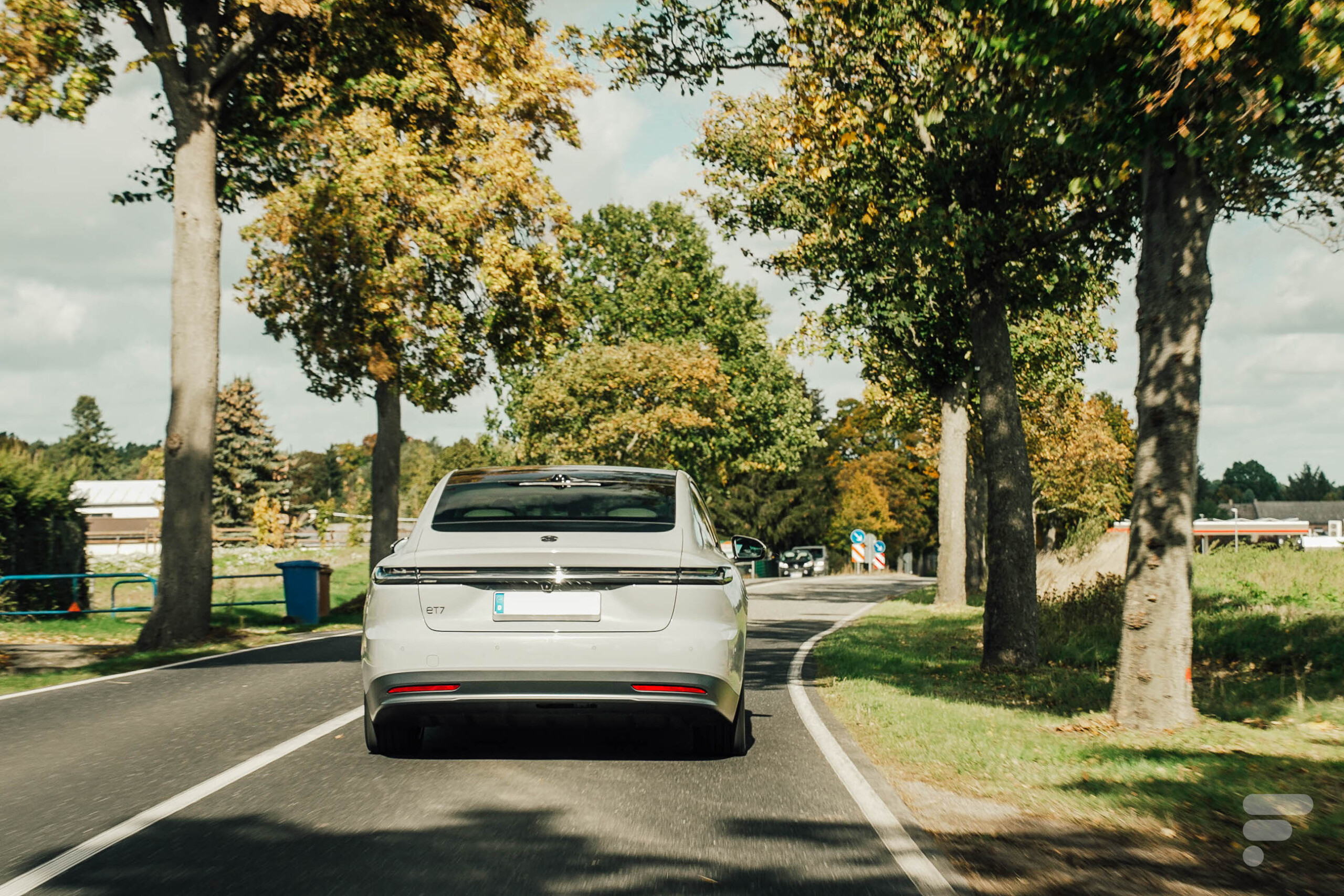
The power is more or less well transmitted to the wheels. However, traction isn’t always exceptional: it’s not uncommon for the tires to squeal during hard acceleration, proving they struggle to handle all that power. But we’re talking about extreme use cases.
The braking is strong, whether it’s friction braking or regenerative braking. The latter is adjustable over three levels, but unfortunately, Nio doesn’t offer one-pedal driving. At low speeds, the car “creeps,” and you’ll need to apply the brake pedal to bring it to a complete stop. The steering is comfortable in comfort mode and more precise in sport mode. It may lack precision in sporty driving. Speaking of which, let’s move on to that part.
We had the opportunity to test the Nio ET7’s performance on the track. Let’s be clear: this is not a sports car at all, except for standing starts. Indeed, the car’s weight significantly hampers it in fast corners, and the inability to disconnect driving aids (ESP and ABS) prevents fully enjoying the car. It’s reassuring and fun for beginners but frustrating for more experienced drivers.

Ultimately, the Nio ET7 plays the perfect role of a chauffeur-driven limousine: comfortable driving with sufficient reserves for safe acceleration and overtaking when needed.
It’s worth noting that this power can also be useful for towing a trailer or caravan. The electric tow hitch (which automatically extends and retracts at the push of a button) allows towing a load of two tons. This is a high value for an electric vehicle.
Autonomy, battery, and charging (in 5 minutes)
Nio promises big things with its ET7. In China, the car is rated for a range of 1,000 km (621 miles) on the CLTC mixed-cycle homologation. However, this is with the 150 kWh battery, which will be available in the first quarter of 2023. It’s delayed due to being a semi-solid type, a first for a production electric vehicle.
Our test model had the 100 kWh battery. In China, it’s rated for 705 km (438 miles). In Europe, on the more realistic WLTP mixed-cycle, it’s around 580 km (360 miles), or 505 km (314 miles) with 21-inch wheels. It’s a shame that the 19-inch wheels available in China aren’t offered in Europe, as they could have increased the theoretical range by about 4%, reaching 600 km (373 miles).
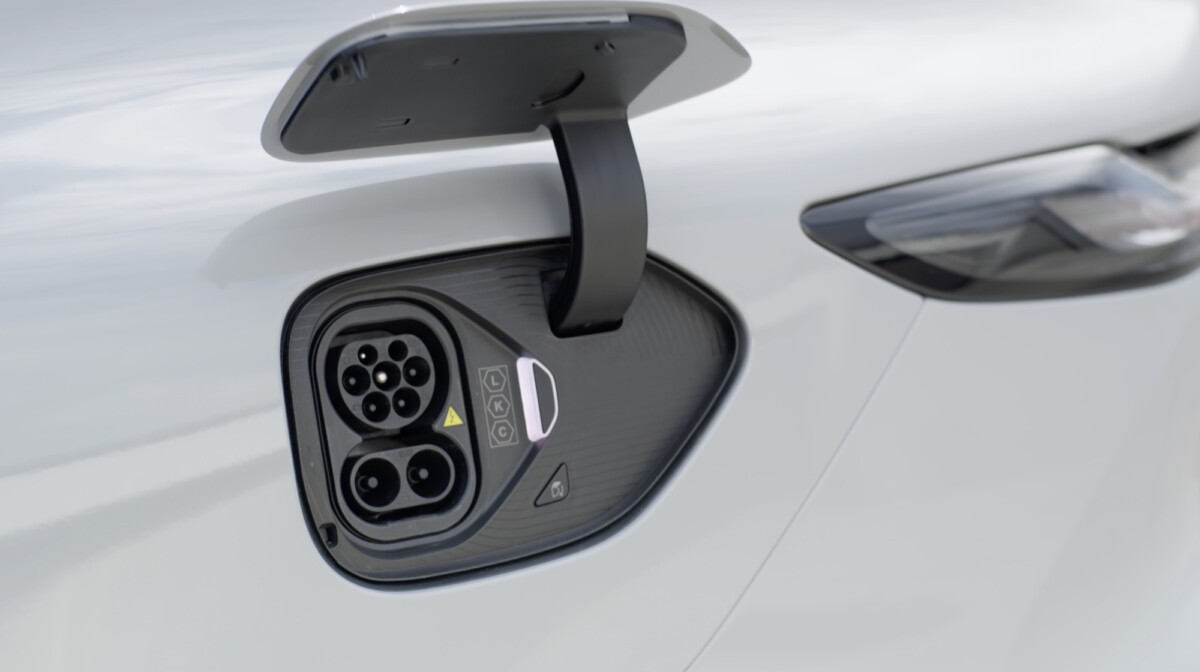
With the 75 kWh battery, the WLTP mixed range is between 385 and 445 km (239-277 miles). For the 150 kWh battery, you can expect about 800 to 850 km (497-528 miles) of WLTP mixed range, instead of the 1,000 km (621 miles) claimed on the CLTC cycle.
We recorded a mixed consumption of 19 kWh/100 km and highway consumption of about 24 kWh/100 km. This is quite high but is similar to the Mercedes-Benz EQS. Both cars share a similar aerodynamic design (drag coefficient of 0.2) and nearly identical weight. In practice, this means about 520 km (323 miles) of mixed-cycle range and a maximum of 400 km (249 miles) on highways.
As for charging, there are excellent aspects, but also some disappointing ones. Starting with fast-charging power: 130 to 140 kW. This is quite low, taking 40 minutes to go from 10 to 80% battery on an appropriate charging station for the 100 kWh version. For the 75 kWh version, it takes 30 minutes. Regarding the upcoming 150 kWh battery, Nio confirmed the charge would take about 50 minutes, which is quite long, similar to a Renault Zoe!
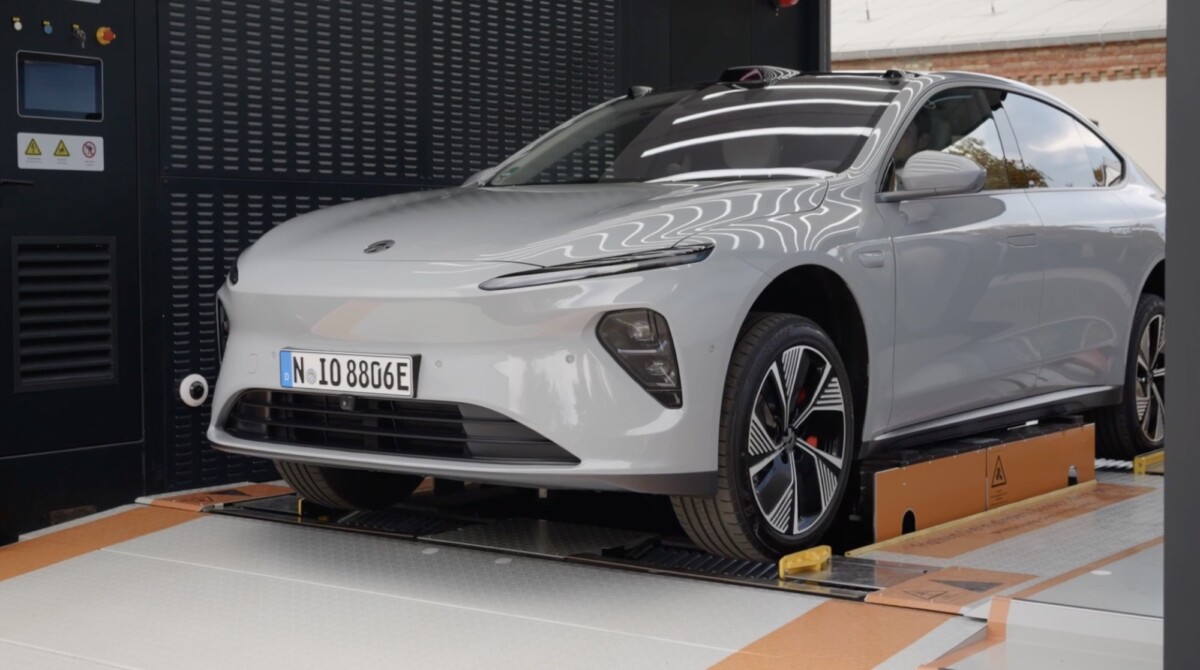
The reason is simple: to produce interchangeable batteries compatible with all the brand’s electric vehicles, Nio faces dimensional constraints. As seen earlier, the batteries are quite thick, affecting onboard comfort and fast-charging. High fast-charging powers require more substantial battery cooling and heavier, bulkier, and more expensive power electronics.
Nio admits that fast charging is not a selling point for the Chinese automaker. Instead, they focus on Power Swap Stations, their famous battery exchange stations. There are currently six in Europe, but we should have 500 by 2025. We tested one in the Berlin suburbs in a dedicated article, and it’s impressive, with a “charge” completed in just five minutes.
Regarding charging, the Nio ET7 offers bidirectional charging with a maximum power of 3 kW to power various devices.
An aggressive price for the features
Currently, the Nio ET7 is available for purchase in Norway and leasing or subscription (non-binding) in Germany, the Netherlands, Sweden, and Denmark. In Norway, the 75 kWh model costs the equivalent of $78,000 (with 20% VAT), and the 100 kWh model costs $85,000.
These prices include battery purchase, with almost no optional extras except for the tow hitch and wheels. If leasing the battery ($130 or $190 per month), the Nio ET7 starts at $67,000.
These high prices place the Nio ET7 in the luxury car segment. For comparison, the new Tesla Model S is priced at $100,000, with better performance, longer range, faster charging, an extra-large trunk, and a frunk. However, it has slightly less refinement and interior space.
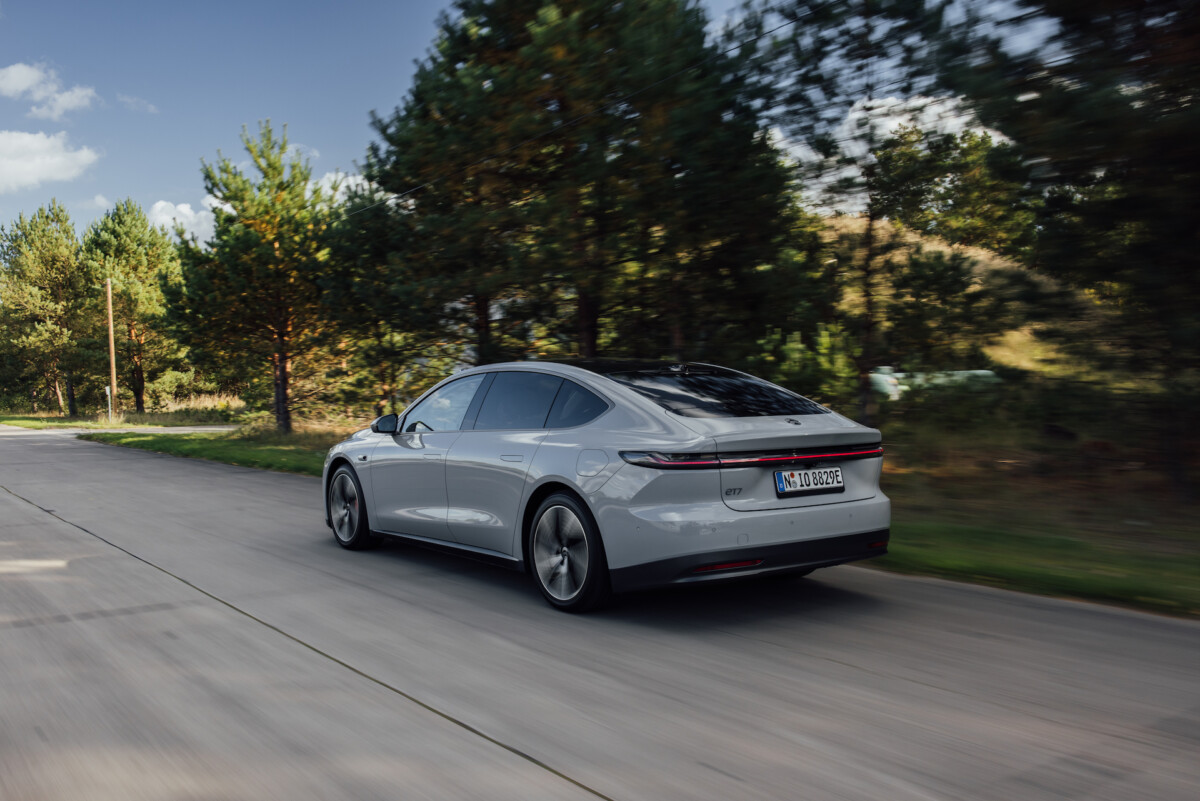
The Mercedes-Benz EQS is out of the running, with an entry price of $136,000. The same goes for the BMW i7, starting at $139,000.
The Audi e-tron GT at $106,000 and the Porsche Taycan at $91,000 come closer, but they move away from the limousine experience and into the realm of sports cars, sacrificing interior space for sportiness.
The Mercedes-Benz EQE is probably the biggest competitor to the Nio ET7, with a base price of $75,000. For this price, you get significantly lower performance (245 hp), no air suspension, fewer options without spending more, but slightly better range at 630 km (391 miles). To get a configuration similar to the Chinese car, you need to spend around $88,000, or $124,000 for the AMG version, which is as powerful as the Nio.
What about France? Unfortunately, unless Nio makes drastic changes (which isn’t impossible), it will be impossible to buy the Nio ET5, ET7, and EL7 . The only option would be to import them from Norway, as it’s the only country where you can purchase rather than lease the vehicle.

